- Search Please fill out this field.
- Manage Your Subscription
- Give a Gift Subscription
- Newsletters
- Sweepstakes
We independently evaluate all of our recommendations. If you click on links we provide, we may receive compensation.
- Travel Products
- Packing Lists

The Ultimate Dive Trip Packing List
Explore new depths with comfortable swimsuits, fitted flippers, reef-safe sunscreen, and more.
:max_bytes(150000):strip_icc():format(webp)/TaylorFoxHeadshot-7375be27aedf4b0ea0e0189a4befe7d0.jpeg)
In This Article
Packing Checklist for a Dive Trip
Frequently asked questions.
- Why Trust T+L
Travel + Leisure / Kristin Kempa
Since earning my Professional Association of Diving Instructors (PADI) certification, I make sure to squeeze in a dive on every vacation. I've had the absolute pleasure of diving in gorgeous places from Egypt to Fiji and, sometimes, renting gear that properly fits and keeps you comfortable throughout an entire dive can be a struggle. I've gone diving in cool waters in which my rented wetsuit didn't keep me warm enough and kicked my way through vigorous dives in which rented flippers leave me with blisters. After nearly ten years of diving, I'm finally investing in my own dive equipment so I can focus all of my underwater energy on taking in the world around me.
Items like regulators and dive computers may seem like investment pieces, but they can be true life savers when you’re 130 feet underwater. On a recent trip, my dive partner ran out of oxygen faster than the rest of our group, so our dive master sent us back to the surface while she continued on with the rest of the group. Without our own dive computer, we would have had a harder time gauging the length of our safety stop before resurfacing. Having your own equipment not only guarantees a safer dive, but it will also keep you comfortable and able to fully enjoy the underwater experience. From reef-safe sunscreen to fitted fins, the proper gear can help keep you safe both in and out of the water.
Whether you’re a lifelong scuba diver or interested in becoming PADI certified, knowing what to bring for a dive trip is key for an enjoyable and stress-free day in the water. “It’s all about having the right gear for you,” Julie Andersen, Global Director for PADI Worldwide and a diver for over 20 years says. “Redundancy isn't a bad word when diving — you should always have back up equipment to avoid dangerous situations.”
While you can certainly rent the pricier technical equipment like regulators and dive computers, if you plan to dive habitually, you should invest in your own, so you know exactly how the product works to keep your mind focused on the dive — not on new gear. Here is everything you need to bring when you’re packing for a dive trip. Whether going for a liveaboard experience or single-dive adventure, this is the clothing, safety products, and gear you should be sure to pack — and some items you may want to leave behind.
Clothing and Shoes
- Best Swimsuit for Women: Carve Designs Lucie Compression Shorts
- Best Swimsuit for Men: Bonobos Throwback Swim Trunks
- Best Rashguard for Women: Athleta Point Break Rashguard
- Best Rashguard for Men: O’Neill Hyperfreak Rashguard
- Best Cover-up: Nomadix Changing Poncho
- Best Waterproof Shoes for Women: Chaco Z/Cloud Sandals
- Best Waterproof Shoes for Men: Keen Solr Sandals
Accessories
- Best Dry Bag: Sea to Summit Big River Dry Bag
- Best Underwater Camera: SeaLife Underwater Smartphone Scuba Case
- Best Sunglasses: Maui Jim The Flats
- Best Hat: Columbia Bora Bora Booney II Hat
- Best Quick-dry towel: Sea to Summit Airlite Towel
- Best Reef-safe Sunscreen: Reef Repair Reef-safe Sunscreen
- Best Water Bottle: Ocean Bottle Recycled Stainless Steel Reusable Water Bottle
Technical Gear
- Best Regulator: Scubapro MK25 EVO/S620 Ti Dive Regulator System
- Best Dive Computer: Garmin Descent Mk3
- Best Mask: Cressi F One Frameless Scuba Snorkel Mask
- Best Wetsuit for Women: Scubapro Everflex Steamer
- Best Wetsuit for Men: IST Full Wetsuit
- Best Dive Hood: Scubapro Everflex Bibbed Hood
- Best Fins: Oceanic Viper 2 Oh Fin
T+L's Top Picks and Tips
When heading out for a dive, packing light is absolutely essential as there’s minimal space on the boat and you’ll be sharing that space with a number of other people. For a day of diving, your bathing suit is the most important item of clothing to consider. “The recommended bathing suit materials would be spandex or polyester,” Eleonora Greggio, a PADI Open Water Diver and Social Media Manager of Reef Oasis Dive Club in Sharm El Sheikh, Egypt, says. “This is because they help protect the most sensitive parts of the body with the wetsuit on: the neck, armpits, and behind the knees. These materials can reduce friction and further protect from UV rays.”
Let’s be honest: when diving, you don’t need to bring a lot more clothing with you than that — keep your post-dive outfit back in your hotel where it will stay safe and dry. Divers should only bring extra layers that provide sun protection and warmth as needed.
Best Swimsuit for Women
Carve designs lucie compression shorts.
While diving, you’ll most likely wear a wetsuit to keep you warm and protected, so just about any swimsuit will work as your bottom layer. However, I tend to get cold on dives, even in warm water, so I love the extra warmth and comfort provided by these compression shorts. Paired with Carve Designs’ Sanitas Compression Top , this suit won’t shift around beneath your wetsuit, which minimizes uncomfortable bunching and increases your maneuverability. In warmer waters, or during shallower dives, you could even consider wearing this compression suit and skip the wetsuit altogether, saving you packing space. (Consult your dive team before making that choice, so you don't end up chilly!)
Best Swimsuit for Men
Bonobos swim trunks.
My husband (AKA my dive partner) swears by these lightweight and comfortable Bonobos trunks. While they aren’t compression shorts, these swim trunks won’t add an uncomfortably bulky layer beneath your wetsuit. You can choose between a five- or seven-inch inseam to get the perfect length that can easily slip right underneath your outer layer. They also come in a dozen colors and patterns, so you can enjoy a pop of fun while lounging on the boat.
Best Rashguard for Women
Athleta point break rashguard.
“Rash guards are a go-to item for divers in all scenarios, from sun protection on the surface to a dive skin underwater,” Andersen says. This Athleta rashguard is rated UPF 40+ for extra protection both in and out of the water. It’s also made of recycled H2ECO swim fabric that can stretch over your swimsuit for a perfect sleek outer layer. You could even wear this in the water for extra warmth or as a wetsuit alternative during warm-water dives.
Best Rashguard for Men
O’neill hyperfreak rashguards.
This water-resistant neoprene rashguard feels just like a wetsuit, but with the comfort of a stretchy tee. You can wear this shirt both in and out of the water as its quick-dry material won't leave you cold and wet. The UPF 50+ rashguard also protects you from UV rays, so you can enjoy a full day out on the boat without worrying about harmful aftereffects.
Best Cover-up
Nomadix changing poncho.
“When you’re diving in cooler to cold conditions, or diving continuously over several days in a row, staying warm and dry on your surface interval is a must,” Andersen says. While some divers may prefer separate bottoms and tops, I like to pack light, so this poncho is a great cover-up for those long dive days. Perfect for divers of all shapes and sizes, this poncho is essentially a lightweight blanket that will keep you warm and dry you off between dives.
Best Waterproof Shoes for Women
Chaco women's z/cloud x2.
On dive trips, shoes are among the last things you'll be thinking about as you almost never wear them on the boat. However, a good waterproof shoe is a must on longer dive trips to keep you safe from slipping on deck. The Chaco Z/Cloud sandals have a rubber outsole that will give you the traction you need on the boat and on land. This pair is particularly comfortable as they have a single, open-toe strap, so you don’t have to wiggle your big toe into an uncomfortable strap as they get wet.
Best Waterproof Shoes for Men
Keen solr sandals.
For those looking for a bit more protection than an average sandal, these Keen Solr Sandals are the perfect next-level water shoe. They offer a closed-toe front for maximum protection, but have strapped sides so water instantly drains out. The Aquagrip rubber soles with slits in the tread also add traction that can prevent you from slipping on wet surfaces.
In addition to dressing appropriately for your dive trip, it can be great to have some personal items to enhance your experience. An underwater camera is great for capturing your dive while sunglasses and a sun hat make sure you’re staying protected as you travel between dive sights. “Sunscreen is also incredibly important after you dive or when you are exposed to strong sun rays,” Greggio says. “For fair-skinned people, we would recommend at least a 50+ sunscreen protection and a cap for hot days to further protect yourself from the sun.” To make sure everything you take with you is safe from water, consider carrying all of your items in a handy dry bag , so you don’t have to rely on boat storage areas.
Best Dry Bag
Sea to summit dry bag.
On your dive trip, the crew will likely take all of your belongings to store in a dry area of the boat, but it’s great to have a dry bag of your own for extra protection. Sea to Summit’s Big River Dry Bag has 20 liters of capacity, perfect for storing all of your daily essentials. Its 420-denier nylon is also reinforced with a TPU film that prevents the bag from tearing and offers an additional waterproof layer.
Best Underwater Camera
Sealife underwater smartphone scuba case.
Instead of learning to use an underwater camera, Andersen recommends bringing the camera you already know best — your phone. “[Once] you have gotten comfortable underwater, and you’ve earned your PADI Advanced Open Water certification, you won’t want to go anywhere without a way to capture all of the incredible moments underwater,” she says. “Rather than learn a new device, I love taking my iPhone underwater, which is why I am very excited about a new option, the Sea Life SportDiver SmartPhone Case, that I now take out for every aquatic adventure.”
This case is compact, easy to travel with, and compatible with most Android phones and iPhones generation 7 and up. It’s also waterproof to 130 feet, which is the perfect depth for recreational dives.
Best Sunglasses
Maui jim the flats.
These polarized, unisex sunglasses are the perfect addition to your boating pack. Not only are they a lightweight pair of sunglasses, they’re also made with a SuperThin Glass lenses inset that doesn't distort the colors of the world around you. With five different frame and lens options to choose from, you and your dive partner can each get a style perfect for you.
Columbia Booney Hat
It can be easy to suffer from sunburn during dive trips. We’re often so focused on getting in the water, we forget about the hours we’re sure to spend on top of the boat — perhaps fully exposed to the sun if you’re with a larger group or on a smaller vessel. This unisex sun hat is easy to pack and provides shade to your face and neck while the mesh interior wicks sweat away. The convenient drawcord will also prevent the hat from blowing away — an absolute must.
Best Quick-dry Towel
Sea to summit airlite towel.
“From boat days to beach days, divers are always in need of a travel towel,” Andersen says. This quick-dry towel is cozy enough you’ll want to use it when you first come out of the water, but it won’t stay wet for the rest of the day. While the towel is 47 inches long, it folds up into a palm-size ball that slips into its own carrying case, so you don’t waste space in your dry bag.
Best Reef-safe Sunscreen
Reef repair reef safe sunscreen spf 50.
In addition to a good sun hat and rash guard to protect from the sun, divers obviously need to pack plenty of sunscreen. “It's important to keep your skin protected from the sun, but use products that are reef-safe and don’t damage the underwater environments you’re exploring,” Andersen says. This creamy, water-resistant formula by Reef Repair was specifically created for the diving industry to protect oceans from harmful chemicals . It also comes in perfect travel-sized bottles that you can bring along wherever you go.
Best Water Bottle
Ocean bottle recycled stainless steel reusable water bottle.
While many dive trips will provide plenty of snacks and water for your full day of activities, it never hurts to bring your own to ensure you’re staying hydrated. “Water is essential before and after the dive,” Greggio says. “It is incredibly important to drink sufficient water before diving, so be sure to bring a water bottle with you. Remember that diving is considered a sport, and as such, you will probably feel incredibly hungry and thirsty when you finish which is why water and a snack are great.”
Depending on which dive shop you’re using, most technical gear will be offered or even included in the cost of your dive trip. However, for frequent divers or those who want to guarantee their gear is in tip-top shape, investing in certain pieces can be a great idea. And I don’t say investing lightly — most dive gear can be quite expensive, so only those who plan to dive frequently should worry about collecting their own technical gear.
“A mask and a wetsuit could be the best investment for a regular diver,” Greggio says. “This is because it is the most personal and can be different from person to person depending on diving necessities or face types. The type of mask also depends on the type of activity you will be doing underwater.”
Best Regulator
Scubapro mk25 evo/s620 ti dive regulator system.
A regulator is an investment piece for sure, but one that can be extremely beneficial to frequent divers. “Owning your own regulator allows you to have peace of mind that you are the only one who has breathed from it,” Andersen says. “[As a] bonus, you also don’t have to worry about adjusting the settings every time you dive. A regulator is a great investment that, with the proper maintenance, will be with your literal life support system for decades. I always recommend investing in this piece of gear thinking about the future of your diving as well, considering how you’ll dive, where, and how frequently.”
Best Dive Computer
Garmin descent mk3.
“Hands down, if you invest in one piece of dive equipment, choose a dive computer,” Andersen says. “Not only is it the most important piece of safety gear that a diver should have on them at all times, but the additional features of dive computers literally also makes them smart devices underwater.” Garmin's latest model has up to 30 hours of battery life on dive mode and will log all of your dive details in the Garmin Dive app automatically, including details like your heart rate and depth.
Cressi F One Frameless Scuba Snorkel Mask
While divers are trained to be able to clear our masks, and you can always pack items to help prevent your mask from fogging up , Andersen highlights the importance of a high-quality mask as your first step to ensuring a clear dive. “A high-quality, low-profile mask with soft silicon is a favorite among most divers,” she says. Masks like the Cressi F One fold flat for easy packing and are made with tempered glass that shouldn’t cause fogging. The quick-adjust buckles are also helpful and can even be adjusted underwater.
Best Wetsuit for Women
Scubapro everflex steamer wetsuit.
Sure, you can rent a wetsuit for any dive trip, but investing in your own guarantees you get a perfect fit that only you will enjoy. “Personally, I’d put buying a wetsuit a close second to a computer, as being comfortable and keeping your body temperature regulated is the number one factor in my dive’s enjoyment factor,” Andersen says. “I love to stay below the surface as long as possible, so having a wetsuit that fits well and keeps me cozy is absolutely key.” This suit comes in XXS-4XL in both long and short sizes, so divers can truly invest in their ideal suit that will last for years.
Best Wetsuit for Men
Ist full wetsuit.
This IST Full Wetsuit comes in men’s and women’s options with inclusive sizing and even different thickness for an optimal fit. “If your suit is too tight, you’ll be incredibly uncomfortable, and if it’s too loose, you can get cold quickly,” Andersen says. “And honestly, I also prefer to know that I’m the only person that’s been in my suit. Simply slipping into a suit that is your own will help you get in the water faster, know the correct amount of weights that you need, and be better able to enjoy your dive.” This suit is also just one pound (depending on the size), so it won’t take up too much space in your packed luggage.
Best Dive Hood
Scubapro everflex bibbed hood.
“ The best way to keep your hair from getting snarled when scuba diving is to invest in a beanie cap or hood,” Andersen says. “Headbands, head scarves, and buffs usually aren’t enough to keep flyaways from escaping underwater, especially if you have bangs. A scuba beanie or hood secures your mane and prevents stray strands from getting in your face or wrapped around your equipment.” Scubapro’s Bibbed Hood comes are ideal for any diver and come in sizes ranging from XS-2XL.
Oceanic Viper 2 Oh Fin
Having a correctly-sized pair of fins can also make or break your diving experience. No one wants to lose a flipper as they jump into the water or resurface with painful blisters. To guarantee you always swim with the best pair for you, divers should consider personal flippers like this Oceanic Viper set that features an adjustable foot strap and streamlined foot pocket for the most comfortable fit.
What’s included in your dive trip will depend on what your dive center offers and how many dives are planned. While most excursions include the cost of renting necessary equipment, other dive centers will charge extra for gear like wetsuits and masks. Often, the cost of a dive trip will include any park entry fees and even meals throughout the trip, so be sure to check with your particular dive shop to find out just what is included for your trip. Remember, whatever the cost, you should always budget for tipping your boat crew and divemaster.
If you want to go scuba diving, you should first become PADI-certified to ensure your safety. During your certification course, you’ll learn essential skills starting in a contained pool. Before you can complete your certification, you will also need to complete four open water dives. These dives can be anywhere your dive shop offers, so many choose to become certified on longer vacations to get the most out of the experience.
Why Trust Travel + Leisure
Taylor Fox is the Outdoor Gear Editor at Travel + Leisure and earned her Open Water PADI certification in Jakarta, Indonesia. She is an avid traveler who has been diving for nearly ten years and has enjoyed dives in Fiji, Belize, Costa Rica, Egypt, and more. For this packing list, she spoke to Global Director for PADI Worldwide, Julie Andersen and Eleonora Greggio, PADI Open Water Diver and Social Media Manager of Reef Oasis Dive Club in Sharm El Sheikh, Egypt.
Love a great deal? Sign up for our T+L Recommends newsletter and we'll send you our favorite travel products each week.
:max_bytes(150000):strip_icc():format(webp)/JasmineGrant-c7aebf391faf4c1c8767a407a955548a.jpg)
Related Articles
- My Dive Gear
- Dive Travel Packing List
- DIY Ear Beer Recipe (Swimmer’s Ear Prevention)
- Scuba Weight Calculator
- Work Together
The Ultimate SCUBA Travel Packing List (Printable PDF)
Free, Reusable, Fillable, Printable, PDF Format
Mobile Friendly
Because this is a PDF, it's easy to take this scuba travel packing list with you on mobile. This means while you're packing for your next dive trip, your packing list is right there in your hand.
The packing list is 100% free and always will be! Just fill out the form below.
The benefit of a digital packing list is that I update and tweak it as needed, and you can always download the latest version!
PDFs are an eco-friendly way to document things. No need to print it out (though you can), you can just open the PDF file and view it, add your own notes digitally, then download a fresh copy for your next trip.
Download the free Ultimate SCUBA Travel Packing List PDF!
- Privacy Policy
- Terms and Conditions
Copyright 2024 CircleHScuba LLC , all rights reserved.

Scuba Diving Earth
Scuba Diving Blog & Forum
Scuba Diver Travel Packing List (Free PDF List So You Don’t Forget Things!)
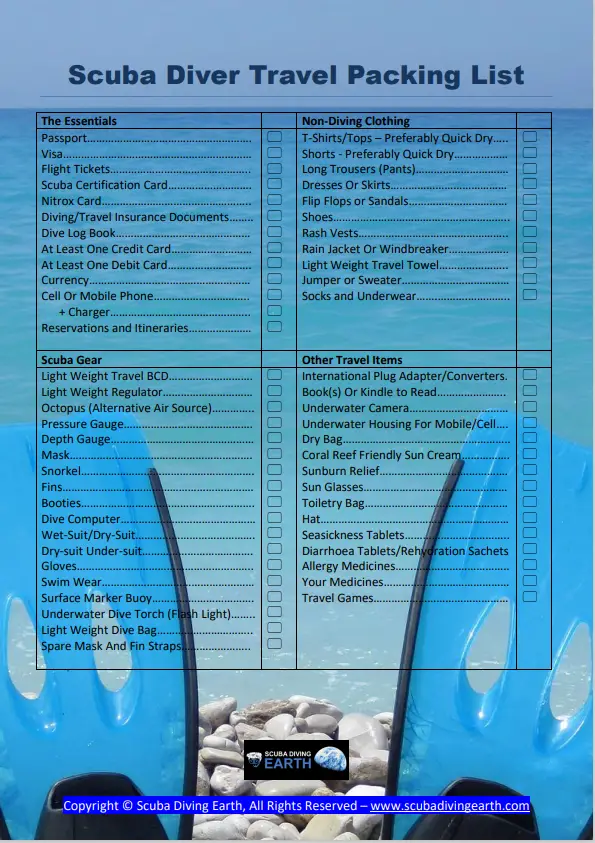
Scuba diving checklist (With a free pdf) to help you remember what you need on your scuba travels
We’ve all had that horrible feeling when you realise you’ve forgotten something. I have! On my last trip to Barbados, my wife and I were in the shuttle bus on our way to the airport when I realised I’d forgotten my underwater camera. This is when a scuba diver travel packing list comes in handy.
EEEK! How annoying!
The best way to do more diving is to book yourself on a scuba diving liveaboard . You can check the latest and best deals on liveaboards using the following window:
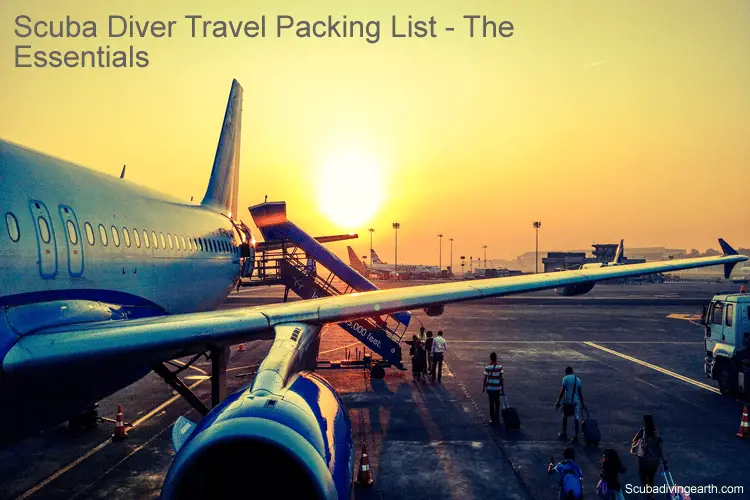
Scuba diver travel packing list – The travel essentials
This first list is about those ‘ travel essentials ,’ without which you won’t be going anywhere. This is especially true if you are flying to another country, which means you’ll need your passport, possibly a visa.
Also, if you forget your diver certification card you may not be diving at all and standing on the side as a spectator.
More Reading : How long should you wait to fly after diving? (What’s safe?)
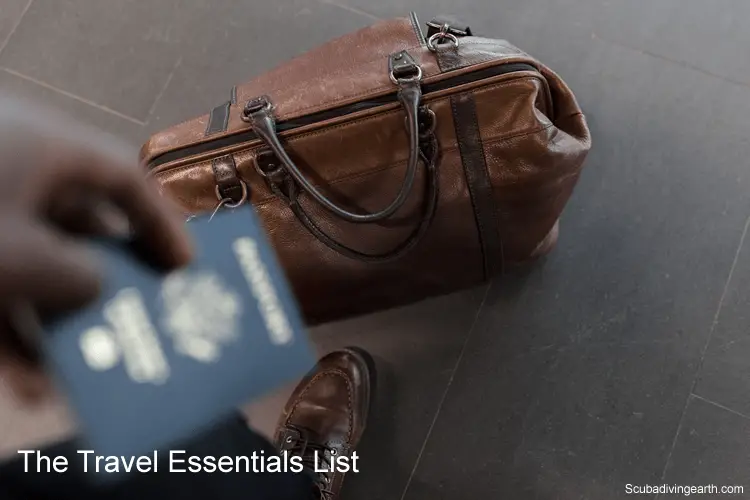
What should I bring on a scuba diving trip? – The travel essentials list
If you forget the items on this list you may be in trouble.
- Passport and Visas
- Reservations and itinerary.
- Flight Tickets.
- Scuba Certification Card.
- Travel/Diving Insurance.
- Currency, Debit and Credit Cards.
- Mobile or Cell Phone + charger.
- Nitrox Card (if you are a nitrox certified diver ).
Scuba diver travel packing list
Are you planning your next trip . Or have you booked your first or next dive trip either at a resort centre or on a liveaboard . Perhaps you’re not too sure what to take, or simply concerned you might forget something.
Don’t worry, as it’s all covered in this article.
But firstly, ask yourself this question: Do you rent your diving equipment or do you buy your gear?

Rent or hire your diving equipment on your diving travels
An important question to ask when deciding about what you take on your diving holiday, for which there are two choices when you travel as a scuba diver :
- Do you rent or hire your scuba equipment from the dive resort or on your liveaboard ?
- Or do you take your own scuba gear instead?
There are pros and cons of both these choices, but this article assumes you’ve decided to take your own diving equipment .
Many experienced divers, myself included, know the value of diving with their own equipment . I always travel with my own scuba gear, much to my wife’s bemusement. With my own equipment I know it works. But also my scuba gear is familiar to me and I know how it works .
My regulator is comfortable and feels safe. I know where all the valves on my buoyancy control device are located. This makes it easier to achieve neutral buoyancy .
If you plan to go on many diving trips an investment in your own quality travel diving equipment is worthwhile.
With that said, let’s take a look at what I consider should be include in your scuba diver travel packing list .
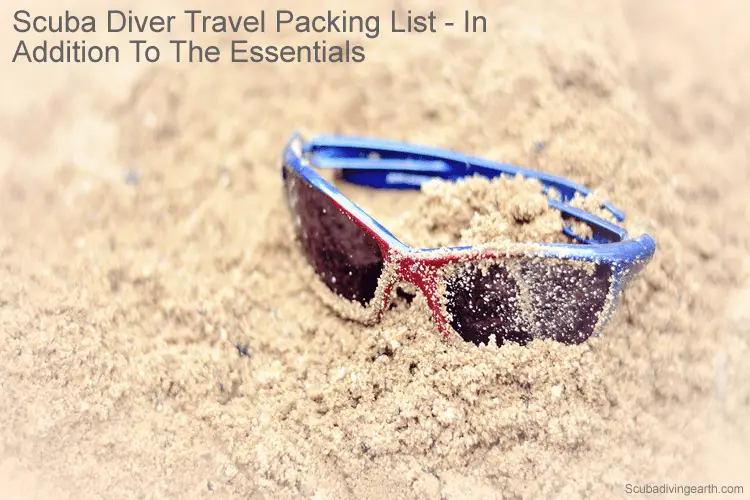
In addition to the travel essentials listed above, the following list includes the scuba equipment essentials to pack.
- Light Weight Travel BCD.
- Regulator with Octopus (Alternative Air Source) and Pressure and depth Gauges
- Mask, Fins and Snorkel.
- Dive Computer.
- Wetsuit or Dry Suit .
- Swimwear Or Dry Suit Under-suit.
- Surface Marker Buoy.
- Underwater Torch or Flash Light
- Light Weight Dive Bag
- Spare Mask and Fins Straps.
- Diver log book.
Airlines have reduced passenger’s baggage allowances . Many airlines also charge separately for hold baggage too. You therefore need to consider your baggage allowance when travelling with scuba equipment, as scuba gear is bulky and heavy.
Let’s take a look at the above scuba packing list in more detail.
Essential scuba equipment for a scuba diving holiday
1. light weight travel bcd.
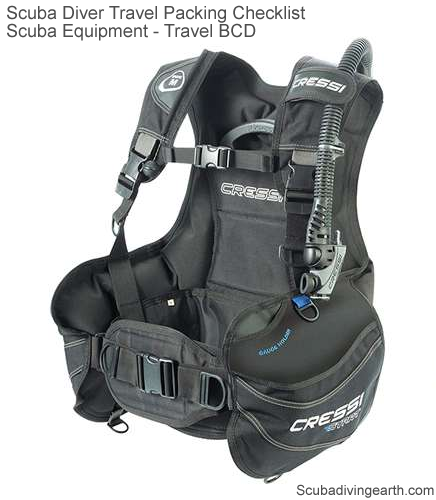
Your buoyancy control device or BCD’s is probably the bulkiest and heaviest piece of your scuba equipment, except perhaps for your wet suit or dry suit . But there are many great light weight travel BCD’s on the market. Many of which are half the weight of a standard BCD .
There are many travel BCDs to choose from, including the following:
- Cressi Travelight and the Travelight Lady Buoyancy Compensators – 2.3kg(XS) to 2.8kg (XL) in black and pink. Italian manufacturer. The Travelight Lady has differently-routed shoulder straps and fastenings to cater for the female form. Material/denier: nylon 210. Integrated weights – Yes. Fully flexible backplate.
- AP Diving Commando Escape – from 2.63kgs (S) to 3.26kg (XXL). British manufacturer since 1969. Integrated weights – No. Rigid backplate. Material/Denier – bespoke OceanSeal 805 (bladder), Cordura 1000 (exterior).
- AP Diving Travelwing – from 2.7kg (S/M) to 2.9kg (L/XL). Integrated weights – Yes. Soft Backplate. Material/denier: bespoke OceanSeal 805 (bladder), Cordura 1,000 (exterior).
- Aqua Lung Zuma – This one is great for travelling as it’s ultra light weight at only 2.2kg (M/L). Material/denier: nylon 420. Flexible backplate. Integrated weights – Yes.
- Mares Hybrid Pro Tec – This is 2 BCDs in 1. It has detachable sections to make it lighter for travel. 4.4kgs (Full version) to 2.2kgs (Travel version) Integrated weights – Yes, but these are detachable. Folding lightweight backplate. Material/denier: Tough Alutex material.
To read more about recommended BCDs take a look at this article: Best Scuba Diving BCDs .
If you’re based in the UK ; click this link to compare prices of a wide range of BCDs from Simply Scuba . But even better, Simply Scuba do an ultra light travel package or other travel packages too – click this link to discover the latest prices . Note Simply Scuba also deliver outside of the UK too.
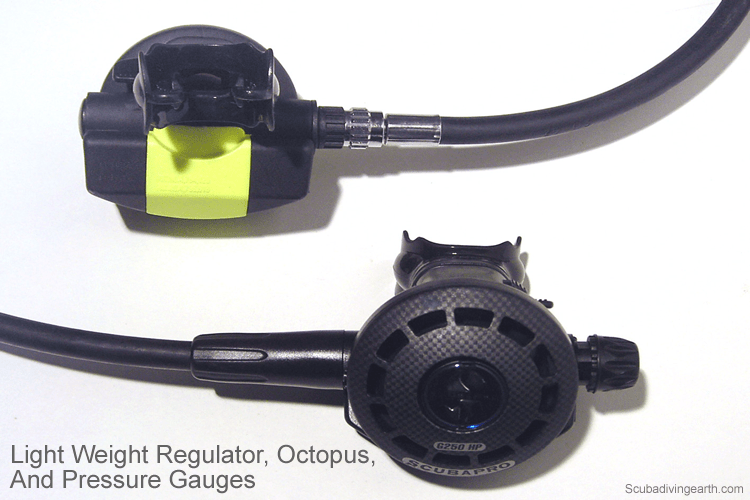
2. Light weight Regulator, octopus, and pressure gauges
This next part of your diving equipment isn’t as bulky as the BCD, but it can be quite heavy. This is your regulator, your octopus (alternative air source) and your pressure gauges .
You can buy light weight travel regs too. This will cut down on your baggage weight, but if you buy regulators with the braided hoses, this also makes them easier to pack.
But as your regulator is one of the main parts of your underwater life support system , always buy high quality regs. Make sure the regulator (and your alternative air source) you buy is made by a reputable manufacturer.
For example Apex, Aqualung, Scubapro and Mares come to mind as companies who make both durable and high quality lightweight regs .
In addition to regulators, you will also need a pressure gauge or air contents gauge. Instead of buying a full-gauge consol, which is both bulky and heavy, you can instead buy a small pressure gauge.
If you’re based in the UK ; click this link to compare prices of a wide range of BCDs from Simply Scuba . And click this link to compare prices of contents gauges .
Depth Gauge
These days I rarely see scuba divers with depth gauges. Most divers use dive computers only. However, when I learnt to scuba dive we didn’t have dive computers. But when these did appear on the market, we were encouraged to have a back up, i.e. a depth gauge.
This is a choice I will leave to you. If you are trying to save space and weight in your baggage, then an extra depth gauge may be left out. These days dive computers are pretty robust and reliable, plus it’s likely your dive buddy will have one if yours packs in.
If you’re based in the UK click this link to compare prices of depth gauges .
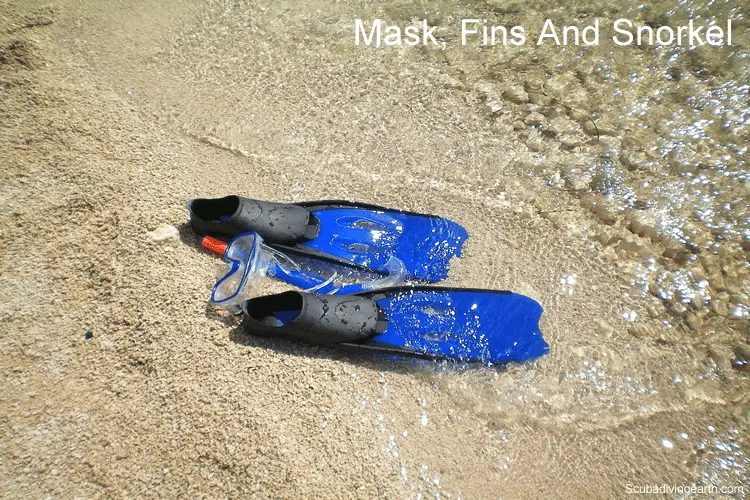
3. Mask, fins and snorkel
If you plan to rent your scuba gear on holiday, one of the items I always recommend you have of your own is a mask. But additionally, you are better to have the whole set of mask, snorkel and fins.
That way, and especially if you’re staying on a dive resort, you have these to go off snorkeling on your own.
Another reason why having your own mask is key is because a poorly fitting mask can either be uncomfortable or it can leak on the dive. At least if you have your own mask, you know it’s comfortable and you know that it fits your face. Which means it won’t leak!
With regards to fins, if you are diving somewhere warm, you can buy the closed heeled (or full boot) fins. These fins are generally lighter than the open heeled fins, but also with closed-heeled fins you don’t need booties. This means you save on bulk and weight.
But if your dive destination is colder you will need to take open heeled fins to either fit over your booties or to fit over your dry-suit boots.
The snorkel you buy should be kept simple. So I recommend you buy a traditional J-shaped snorkel without any fancy valves that close-off when you dive underwater. That way it’s smaller and less bulky and lighter too.
If you’re based in the UK, click this link to compare prices on masks .
If you are diving in warmer climbs, you can take the full boot fins, as described above. But if you are going to be diving in colder water, you may need to pack booties. But if it’s going to be really cold, then a dry-suit may be in order, in which case you won’t need booties.
Another consideration for using booties with open-heeled fins is comfort. Full-boot fins can cause blisters when used for long periods of time. Whereas wearing booties with fins, you probably won’t suffer from this problem.
If you’re based in the UK, click this link to compare prices of booties.
5. Dive computer
There are so many dive computers on the market these days, it’s difficult to know which one to choose. But a dive computer has become an essential part of diving equipment.
One quick tip for traveling with your dive computer is to always carry it with you on a flight in your hand luggage. This keeps it warm in the cabin and it is then kept at cabin-pressure too, rather than being in the cold and low pressure hold.
I recommend you invest in your own dive computer though. This way you know how to set it and how it works. But also you recognise the alarms when they go off underwater.
Probably my next investment will be in a watch-style dive computer. This is ideal for travelling , as you can simply wear it on your wrist the whole time.
If you’re based in the UK, click this link to compare prices of a wide range of dive computers from Simply Scuba .
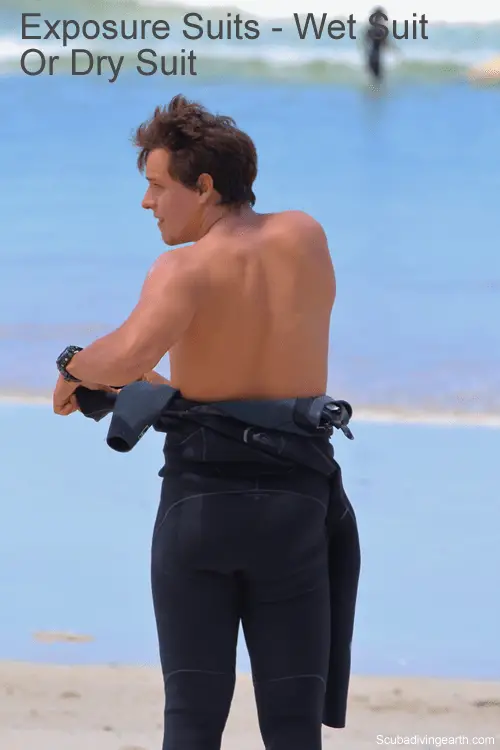
6. Exposure suits – wet suit or dry suit
If your dive trip is to somewhere warm and sunny you may not even need a wet-suit. But no matter where I dive, I always take mine with me. A wet suit not only keeps you warm, but it also provides skin protection underwater too.
Like your BCD, your wetsuit is also bulky and heavy.
Another quick tip about your wet suit is to make sure you give it time to dry on your return journey. A wet wet-suit will be extra heavy.
If the waters where you intend to scuba dive are particularly warm and you are someone who doesn’t feel the cold, then you may wish to use a Lycra suit instead. This will protect your skin, as a wet suit does, but it won’t keep you warm in the same way as a wet suit does.
Finally, if your destination is to a place where the water is really cold, then a dry suit may be a better option. However, travelling with dry suits will make your baggage even heavier.
Dry suits tend to be much more bulky and heavier than wet-suits. Plus, and depending on the type of dry suit you have, you may need an under-suit or woolly-bear to keep you warm.
If you’re based in the UK, click this link to compare prices of a wide range of wetsuits from Simply Scuba . Or for drysuits – click this link to compare drysuit prices from Simply Scuba .
Although I own a couple of pairs of diving gloves, I rarely ever use them for diving. I prefer to be able to feel things better with my bare fingers.
However, if you prefer to have your hands covered up, then I suggest you take some lightweight dive gloves with you.
If you’re based in the UK, click this link to compare prices of a wide range of gloves from Simply Scuba .

8. Swim suit
You will need to have something to wear underneath your wet-suit. So you need to take at least one swim suit with you.
However, if you are dry-suit diving, then a swim suit is replace by an insulating under-suit.
9. Surface marker buoy
If you plan to dive in a region where drift diving is likely, a surface marker buoy is a good addition to your diving equipment.
More Reading : What is a surface marker buoy used for? (Safety diving equipment)
10. Underwater dive torch or dive light
I always take a dive torch or dive light on my dives. This is even during the day. There are many crevices and holes to be explored on almost every dive. These are better seen using a torch.
More Reading : Why use a diving torch scuba diving (It’s not just for night diving)
You’ll also find a torch comes in handy to light-up certain creatures. You’ll sometime be amazed at the true colour of some creatures when they are lit-up.
Also, a dive torch is a necessity if you’re planning on doing night diving too.
If you’re based in the UK, click this link to compare prices of a wide range of dive torches from Simply Scuba .
11. Light weight dive bags
Your diving equipment will fit into a normal suitcase. But if you’re staying on a dive resort, it’s a good idea to have a separate light weight dive bag to carry your scuba gear to the dive shop or to the dive boat.
You can also buy dive bags that you can put your diving equipment into for your flight too. This type of bag will be useful for either a reseort diving trip or aliveaboard diving trip.
If you’re based in the UK, click this link to compare prices of a wide range of dive bags from Simply Scuba .
12. Spare mask and fin straps
Another useful tip is to carry spare straps for your dive mask and fins. Alternatively, make sure you check these before you leave.
If any of your straps are perished or looking like they may break, I suggest you replace them before you pack these into your luggage.
13. Diver log book
If you log your dives, don’t forget your log book. This can also be important to prove the dives you’ve done too.
What to bring scuba diving – The non-diving clothes
So you now have the essentials for your dive trip together with your scuba diving equipment, what else do you need?
The first of these is your non-diving cloths, which includes the following items:
- T-shirts or tops – preferably quick dry.
- Shorts – also preferably quick drying.
- Long trousers or pants.
- Dresses or skirts.
- Flip flops or sandals – or if you’re from Australia; thongs.
- Rash vests.
- Rain jacket or windbreaker.
- Light weight travel towel.
- Jumper or sweater – just in case it gets cold.
- Socks and underwear.
What to bring scuba diving – Other travel items
There are other sundry items you’ll need on your scuba diving holiday, which include the following items:
- International Plug Adapter/Converters.
- Book(s) Or Kindle to Read.
- Underwater Camera.
- Underwater Housing For Mobile/Cell phone.
- Coral Reef Friendly Sun Cream.
- Sunburn Relief.
- Sun Glasses.
- Toiletry Bag.
- Seasickness Tablets.
- Diarrhoea Tablets/Rehydration Sachets.
- Allergy Medicines.
- Your Medicines.
- Travel Games.
And that’s it. If you take everything on this list, you’re set to fly to your scuba diving destination. Enjoy and don’t for get to send me a postcard.
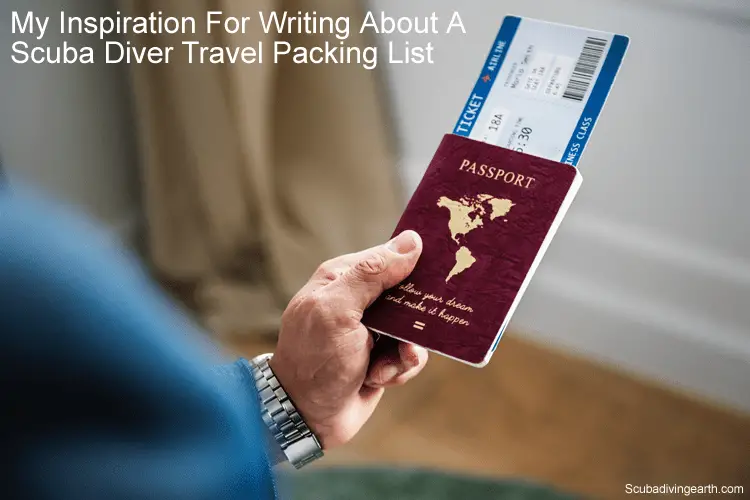
My inspiration for writing about a scuba diver travel packing list
Only recently I drove two and half hours to London Gatwick. We arrived the night before, in preparation for an early flight the following morning.
It was only when we were in the hotel room when we realised our passports were on the seat of a car we didn’t have with us! Our passports were at home! OMG!
I then had to drive two and a half hours back home. And then two and a half hours back to London Gatwick once more! I finally arrived back at the hotel about one hour before we were due to leave for the airport!
I was tired, but at the same time relieved we had discovered the missing passports the night before and not in the morning. If we’d found this out in the morning, we would have missed the flight and not gone on our holiday.
This incident is what prompted this article for a packing list for dive travel . I know this sort of thing happens to the best of us. I know I’m not alone in sometimes forgetting the essentials .
If you want to download a free Scuba Diver Travel Packing List PDF , please see below. But in any case I’m going to run through what should be on this list for you now.

Before you buy and certainly before you fly
As already mentioned, airline baggage allowances are generally reducing. At best you can check-in a bag weighing 32kg, but at worst you’ll only be able to check-in a bag at only 15kg.
Be very careful about an oversight with your baggage weight, or you could find yourself handing over cash for even the slightest packing oversight .
Your allowance will depend on your destination and carrier you choose to fly with. Excess baggage fees can vary from £3 per additional kilo to upwards of £50 per additional kilo! Some airlines will charge less if you pre-pay any excess. But most, if not all, will penalise you heavily at check-in.
Full set of diving gear
A full set of dive gear can take up your entire baggage allowance all by itself. This is why my wife always teases me when I take mine with us on holiday. It usually means I need two check-in bags. One for my dive gear and one for everything else.
Some airlines will allow dive gear as ‘sporting goods’, but there doesn’t seem to be any consistent approach on this.
If you buy well when sourcing your diving equipment. If you buy lightweight travel BCDs for example, this will make a huge difference to the size and weight of your hold-baggage.
Multiple airlines on route to your destination
Depending on your destination and where it is in the world, you may find you take more that one flight. these separate flights may in fact be with different airlines.
If this is the case with your holiday or vacation, make sure you check the baggage rules for each airline company.
Liveaboard diving holidays
If your dive trip is a liveaboard diving holiday , then you should be able to pack efficiently. This is especially true if the liveaboard trip is to somewhere like the Red Sea or Indonesia , when it’s warm and you won’t need much in addition to your dive gear.
In the Red Sea you’ll probably your swimming costume, shorts, T-shirts, a pair of flip-flops in addition to your diving equipment, Plus a change of underwear for your return journey home.
I hope you enjoyed this article about a scuba diver travel packing list
I’d love to hear from you. Tell us about your adventures of diving and snorkeling, in the comments below. Please also share your photos. Either from your underwater cameras or videos from your waterproof Gopro’s!
If this article hasn’t answered all of your questions. If you have more questions either about snorkeling or types of scuba diving ( or specifically about a Scuba diver travel packing list ), please comment below with your questions.
There will also be many more articles about scuba diving (and snorkeling) for you to read and learn about these fabulous sports.
Have fun and be safe!
Related Posts:

Russell Bowyer
Article written by Russell Bowyer who has been a scuba diver since diving on the Great Barrier Reef in Australia in 1989. After his first dive he trained as a BSAC diver in the UK. He attained his Diver Leader certification with BSAC. He then went on to become a scuba diving instructor, teaching others how to dive and was voted as Diving Officer and Treasurer for the Saffron Walden BSAC club too. Russell has dived all over the world, including the UK, on liveaboards in the Red Sea , the Caribbean, South Africa and the USA. Russell is experienced in all dive types, including drift diving, deep dives that involved decompression stops and recreational dives too.
Leave a Reply Cancel reply
Your email address will not be published. Required fields are marked *
Save my name, email, and website in this browser for the next time I comment.

Dive Travel Packing Checklist

Basic Packing Checklist
The following packing checklist is not comprehensive. It is intended to provide a foundation to make it easier for you to customize according to the specific details of your trip. Copy, scan, or retype and customize this list, adding in any specialized equipment you need, as well as your clothing, toiletries, and other personal items necessary for your trip.
- Certification card (C-card)
- DAN membership card
- Nutritious snacks
- _________________________
- Booties/fins
- Cutting tool or dive knife
- Dive computer
- Exposure suit
- Surface signal
Specialized equipment (optional)
- Camera and other photography equipment
- Diver propulsion vehicle (DPV)
- Oxygen unit
“Save-a-dive” kit
- Defogger spray
- Duct tape and waterproof adhesive/sealant
- Fin buckles and straps
- Mask strap or extra mask
- Multi-tool (including an adjustable wrench and hex key)
- O-ring kit (including O-rings for high- and low-pressure hoses, an O-ring pick and silicone grease)
- Regulator mouthpiece
- Snorkel keeper
- Weight belt or buckle
- White trash bag (or some white working surface)
- Zip ties/cable ties and bungee cord/shock cord
- Dive tables
First-aid kit
- Nitrile (hypoallergenic)
- CPR barrier (oronasal)
- Safety pins
- Soap (or antiseptic solution or wipes)
- First-aid guide
Dressings and bandages
- Adhesive bandages (such as Band-Aids)
- Gauze pads and rolls
- Triangular bandages
- Elastic bandages(such as Ace Bandages)
- Medical tape
Accessory items
- Sterile saline solution
- Irrigation syringe
- Hot and cold packs
Medications
- Acetaminophen (such as Tylenol)
- Ibuprofen (such as Motrin or Advil)
- Diphenhydramine (such as Benadryl)
- Hydrocortisone cream
- Antibiotic ointment
- Dimenhydrinate (such as Dramamine)
- Loperamide (such as Imodium)
- Antacid (such as Tums)
Next: Travel Preparation Timeline >

The Ultimate Scuba Packing List And Tips – Dive Vacation
As a scuba diver, I can’t imagine not having a scuba packing list of items checked off before I leave for vacation.
There’s nothing worse than sitting on a dive boat and taking out your gear and realizing you forgot an important piece of dive equipment. You thought you had everything all organized when you packed.
Packing for a dive trip requires extra planning. Remember, not only do you have to pack to travel, you have to pack all your scuba gear and still meet your airline’s baggage allowance.
Using a scuba packing checklist to help you get organized will not only give you an enjoyable stress-free vacation but will also help you to not miss any gear when packing.
The Ultimate Scuba Packing List is an inventory list to help you never forget all your important travel needs for your exciting dive vacation. It gives you helpful information on what items to put in your Carry-On and in your Check-in bag and I also have a great video for you to watch.
Table of Contents
Scuba Gear Packing Tips: Carry-On Bag
There is some dive gear you absolutely want to protect from being damaged and will want to put into your Carry-on bag . Items like your regulator , dive computer, dive watch, camera and lens should all be packed in your Carry-on in addition to what is shown under ‘Basics (Carry-on) of The Ultimate Scuba Packing List below.
Pre-Packing Tips for Your Carry-On Bag:
1) Remember, never pack your dive knife in your Carry-on. You may be in for a big surprise with airport security if they find it in your Carry-on.
2) Your regulator should be put in a padded regulator bag.
3) Dive computer and dive watch. It won’t be fun to rent these and spend time learning how to operate someone else’s and not only that, it means not having your own dive profile.
3) Certification card. Forgetting to bring this card may mean delays or missing a dive and waiting until the dive center retrieves your information online from the appropriate dive agency.

4) Prescriptions and seasickness medications including decongestants. Having these with you at all times during your travel to remote places can save you a lot of grief if your Check-In bag arrives late. Trust me, I’ve seen divers go thru the stress of not having immediate access to their prescriptions.
I love my diving and I love being on the boat BUT I get seasick easily.
I will never forget the time time of when I forgot my Ginger Gravol. This caused me to purchase my seasickness alternative at a remote vacation destination and after my dives, I slept my afternoons away. If you are prone to seasickness or unsure, please do not forget to bring your seasickness preventative.
Scuba Gear Packing Tips: Check-In Bag
1) Fold and place your wetsuit in first for padding in the bottom of the bag and then put your BCD in the middle on top of the wetsuit. Place your fins on either side of your Check- in bag which makes for a sturdy wall.
2) Your mask without the snorkel should go in a protective container to protect the lens from being scratched.
3) Remove the batteries out of the dive light(s) and put them in a small container. The batteries should actually go in your Carry-On Bag.
4) Start filling in the spaces with your mask box, snorkel, dive lights, etc.
5) Be sure to bring a mesh bag with you to put all your dive gear in and to carry back and forth from the hotel to the dive center. It’s also a perfect bag to dunk and pre-rinse your gear.
Ultimate Scuba Packing List Checklist
Here is an instructional video for you to watch and it will give you some great ideas on how to pack your dive gear in a gear bag.
What have you forgotten on your dive vacation and what did you do to replace it? Did you rent your missing dive gear at a dive center? How do you pack your bags in preparation for your dive vacation?
If you have any stories you would like to share or have any questions or comments, it would be awesome to hear from you. Please put them in the Comment Box below.
Thanks for reading!
Leave a Comment Cancel reply
By using this form you agree with the storage and handling of your data by this website. *
- Earnings Disclaimer
- Privacy Policy

Dive Packing Guide: What to Pack?

So, you’re booking a diving vacation abroad in some beautiful location for the first time, you may be wondering what you should be packing. Okay, so you will need to pack much of the usual stuff as a normal vacation such as weather-appropriate clothes, toiletries, sun cream, camera, and other similar items.
You’ll also need to base the amount you pack on how long you are going away for. In addition to normal things you need to pack, you obviously need to pack your essential diving gear . But where is the limit? You don’t want to be stung by extra costs for having overweight luggage – but you also don’t want to be without your important pieces of equipment.
Table of Contents
The Ultimate Dive Packing Guide: Everything You Need For a Dive Trip
We’ve looked at all your different pieces of scuba diving gear and what best fits in your scuba dive bag , so if you’re unsure about the basics you should pack, you’ll find lots of valuable information here.
In the following post though, we are going to look at traveling with dive gear and the best way to pack everything, as well as some things you should probably just leave at home. Are you planning a winter trip? Make sure you check out our best places to dive in winter post!
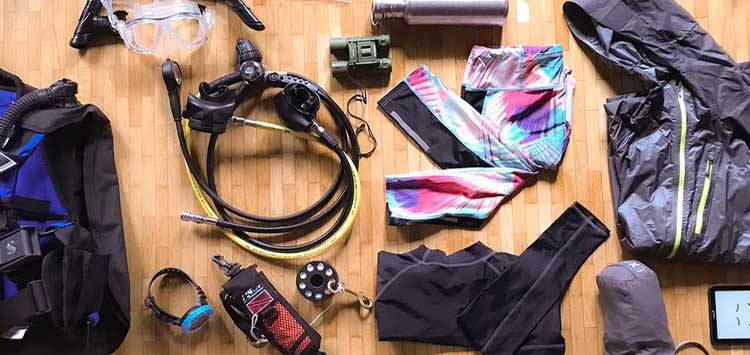
1. Taking All Your Diving Gear

This not only makes for a more enjoyable and comfortable diving experience because you’re familiar with the stuff, but it also can help you save on expensive rental costs.
Ideally, you should consider packing two bags – one to keep your clothes, etc in and one for all your diving gear.
You need to be careful to monitor the weight of your bag, especially if you are taking everything with you on a plane, as there are airlines that allow you to have a scuba diving baggage allowance of up to 10kg. Always check the airline you are flying with offers this,
2. What if You Have Restricted Weight?
If, though, for some reason, you are restricted in the amount of weight you can carry, you will need to consider leaving some of your equipment behind.
The type of traveling and diving you are participating in will help determine the equipment and gear you should take with you and stuff you could rent.
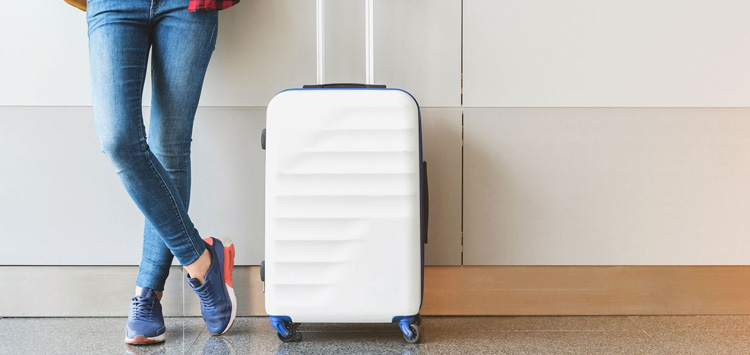
Mask and Snorkel
It’s generally a good idea to bring your mask and your snorkel. Rentals are never as good as your own gear and they can sometimes be faulty or just uncomfortable, and no one wants that.
Masks and snorkels are both lightweight enough that they won’t take up much room in your baggage anyway! So it makes sense that they come along with you on your dive trip.
BCD and Regulator
By far the two most important parts of your equipment. If possible, you should try to bring your own regulator and BCD. Nowadays, most BCDs are travel-friendly and compact ideal for these kinds of situations.

Dive Computer
Similarly, dive computers are another piece of kit that is expensive to rent. So it’s best to take your own one with you. Not only this, but your dive logs will be stored on your own device rather than someone else’s.
You’ll also not have the hassle of having to learn how to use it a new dive computer!
Fins are something of a grey area because if you know you are only going to be using open heel-style fins, it won’t be too problematic renting them if you’re bringing some boots.
However, poorly fitting fins can just make the whole experience stressful and as far away from being fun as possible. If you have your own, take them with you! They can easily slot in the sides of your bag and not take up too much space.
Whether you bring your own wetsuits will depend really on the water temperature where you are diving. If the cold is going to be an issue, pack your own wetsuit.
However, if the water is going to be warm, leave your wetsuits behind and just rent one . Whether you take any of the above or choose rental options, is obviously down to your own preferences.
3. Items You Definitely Don’t Need to Bring
In order to figure out the most important items that you need to bring with you. You need to make a list, whether it’s a physical or mental one.
Now, we are going to discuss some of the items that you really don’t need to bring .
Weights and Tanks
These are normally included as part of most diving trips and you can get them from diving centers.

You won’t need to bring any of your own diving tools as most centers have these in an abundance .
If you really feel it’s necessary to bring some of your own tools, stick to a smaller set with basics like O-rings, etc., rather than a big comprehensive one.
We hope the above post has been helpful. Even if you are still not sure what you’re going to bring on your diving vacation and what you’re going to leave behind, we’ve given you some food for thought.
Ultimately a lot of it depends on your own preferences and plans.
Scuba diving is more than a passion to me, it's a part of who I am. Now, I travel and dive as much as I can, exploring the world, trying new dive gear, discovering dive destinations and reviewing them here for you. All while educating people of the threats our marine life and oceans face every day and what we can do to help defend it.
You may also like
Scuba diving the ss thistlegorm wreck, manta ray dive kona, scuba diving yongala ship wreck, leave a comment cancel reply.
Save my name, email, and website in this browser for the next time I comment.
The best gifts for divers
FREE diving tools
Important diving terms
Our collection of E-Books
Gear reviews
Free Scuba Diving Packing List
The ultimate scuba diving packing list!
The day has finally come. The vacation has long been planned, the flights are booked and you are ready to depart.
The only question is: How to pack for a dive trip?
In this article, I will give you a list of things you need in your suitcase when traveling to other places for scuba diving and give you some tips and tricks I have picked up over the years.
You can also download this scuba diving packing list and bring it on all your dive trips from now on!
The ultimate scuba diving packing list 2024
If you are packing right now and desperate to read the list, here it is without further ado. You can leave this page open and checkmark what you have right here.
Important Documents
Hygiene & medical, beach & swimming, clothes (diving specific), electronics.
This is just the list that is mostly specific to scuba diving trips. Of course, you’ll need to pack shirts, pants, underwear, and so on, as well.

How to pack for a dive trip?
Although the past months have not been the best for diving trips, 2024 is bound to be great for scuba divers!
Packing for a diving trip is a little different than packing for a beach vacation or city trip. Obviously, you will need clothes and other travel items, as usual. In addition, surprise surprise, you will take your scuba gear (if you own any).
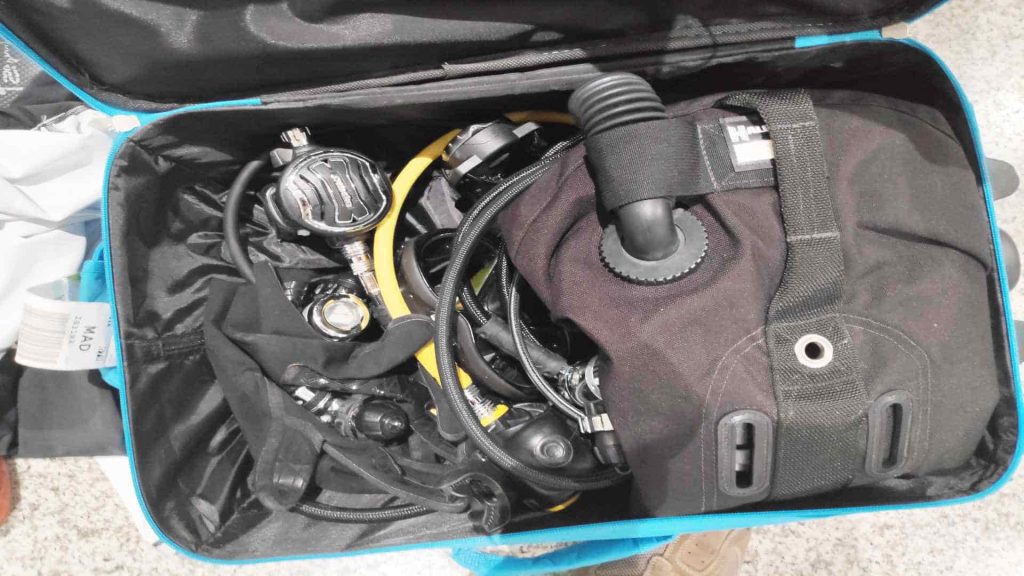
However, don’t just bring everything you have and try to make it fit in your suitcase just to end up with overweight charges at the airport.
Instead, ask yourself a number of important questions related to the specific location you’re traveling to and the kind and amount of diving you’ll do there.
For example, “ how many spare batteries for your computer are necessary? ” and “ do you really need a sweater in Egypt in the summer? “.
I have done some quite extensive traveling in my life, both for scuba and non-scuba diving activities and the most important lesson I have learned was: Less is more when packing for a dive trip!
Less is more when packing for a dive trip!
In general, there are only a few things that must not be forgotten, and they usually aren’t even connected to scuba diving at all. Passport, credit cards, visa, underwear…you get the point.
The only things you really need in regard to scuba diving are your logbook, your dive insurance card, and your scuba certification card.
The rest can always be bought, rented, or borrowed on-site, even last-minute. Trust me, you’re not the first diver (and won’t be the last either) who forgets a mask, dive computer, or couldn’t fit their BCD into the suitcase.
Diving trip operators know this and prepare accordingly. 😉
Oh, and yes, you DO need a sweater in Egypt, even in the summer and two spare batteries are usually sufficient for any given trip.
Important questions to ask before a diving trip
Here are some things I ask myself before I travel:
What will the weather be like at my destination?
Check your weather app on your phone or computer or simply ask the trip operator about the current weather at your destination.
I will not bother explaining why your packing list might need adjustment depending on the weather.
However, keep in mind that after days of diving you WILL get colder, even if the outside temperatures are super high. This is especially true on multi-day liveaboard safaris.
What kind of accommodation have I booked?
Some diving camps may only provide shared showers at the lower-priced apartments, while other dive resorts do or do not give you beach towels. Make sure to pack accordingly.
Will I be on a boat?
You will not need shoes on a liveaboard (in fact, some boat operators forbid you from taking them on board in the first place), but you might want to pack some medicine against seasickness, or an extra power bank for charging your devices.
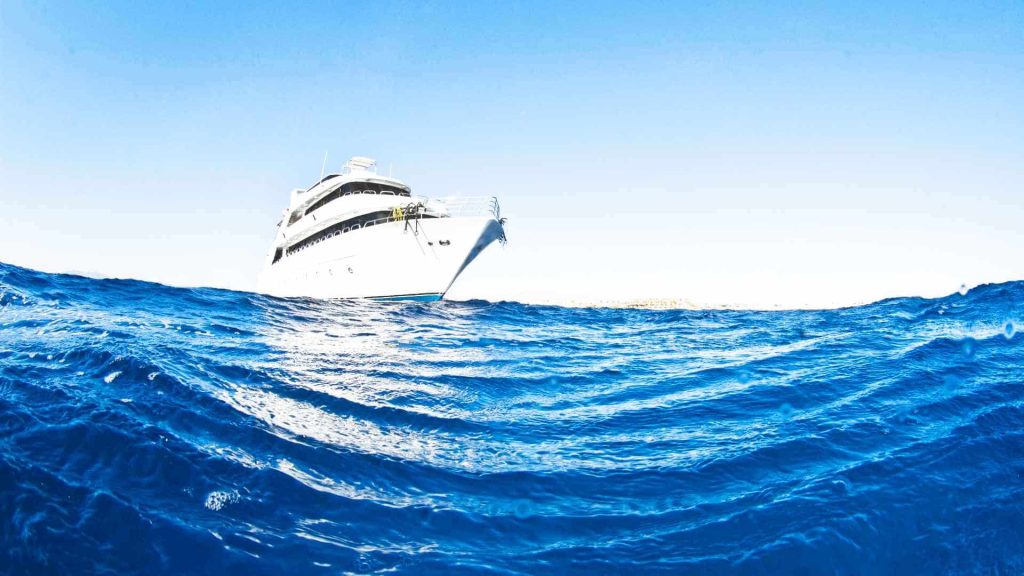
How much of my vacation will be spent diving?
The more you dive, the less time you will have for other activities…and vice versa. If you travel for one week and booked 5 or 6 diving days (abide by the no-flight times!) you will most likely not need your hiking boots.
On the other hand, if you only want to get in a couple of days of diving, consider renting certain pieces of equipment to save space and weight in your suitcase.
What kind of diving will I be doing?
Boat dives mean you need a surface marker buoy (SMB), which will not be necessary when ice diving in a lake. On the other hand, please leave your drysuit at home if you plan on diving in anything warmer than 24-26°C. 😄
What are my airline’s regulations in regard to (diving) gear?
Some airlines don’t allow you to take certain pieces of equipment onboard without prior approval or extra fees.
Li batteries for your underwater camera and underwater torches, large knives, and other special scuba gear parts often cause some issues, especially when you try to bring them in your carry-on (please put the knives in your suitcase).
If you need a second suitcase, be aware that many airlines charge extra for diving gear and will require you to check it in at a separate counter.
What kind of valves are in use at my travel destination?
Make sure to check whether the tank valves at your dive resort or boat are DIN or INT. In case they differ from your own setup, get an adapter or consider renting the regulator (although I don’t recommend you do).
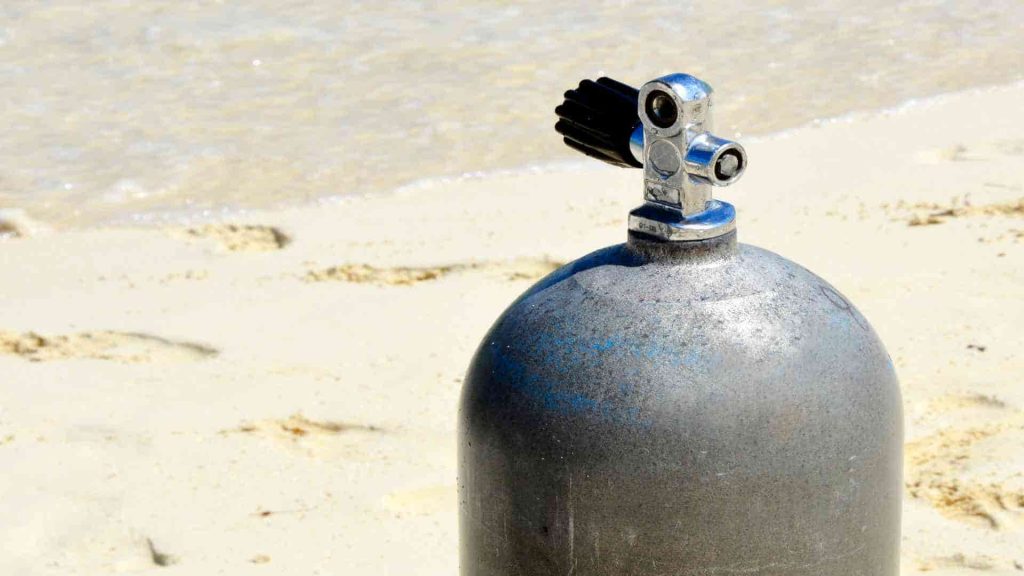
Is there anything I absolutely cannot buy at my destination?
You can always buy more shirts and swim trunks wherever you go. Are you someone who likes to bring home souvenir shirts? Leave some of your own at home and save space.
On the other hand, prescription medicine absolutely needs to go with you, as well as your logbook and scuba certification card!
What could be useful on a dive trip besides scuba gear?
I like to always bring a few things which have nothing to do with diving but make sure the vacation gets even better.
Especially on liveaboard safaris, a small speaker for listening to music is super convenient.
I always bring two or three extra chargers for myself, guests, and other divers in case they forgot theirs and it does wonders to make you new friends. 😄
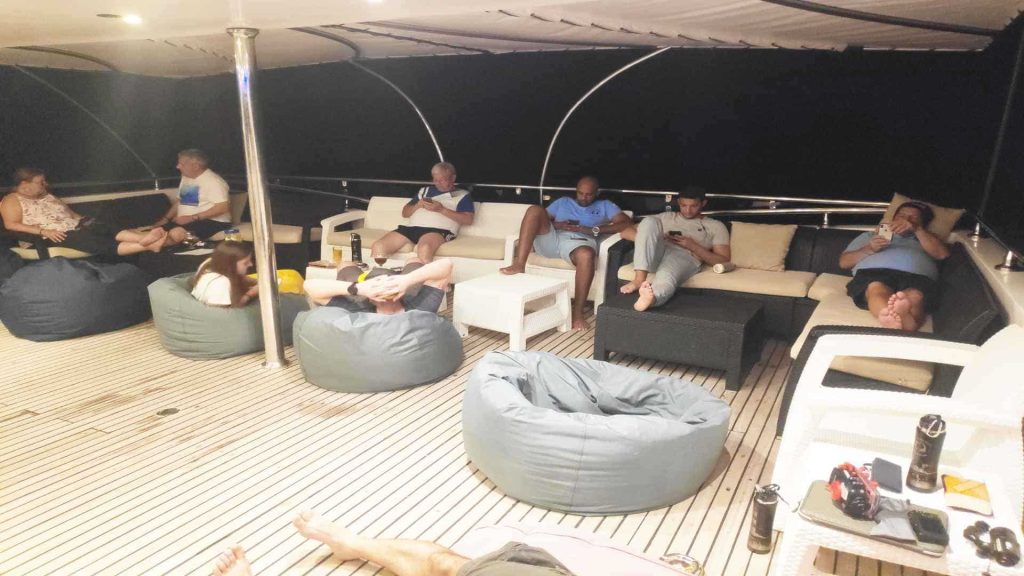
Additionally, it’s always nice to have at least one “nice” outfit in case there is an after-dive party or get-together. Sure, beachwear is convenient, but who doesn’t like to dress up a little more and enjoy the same from their travel companions?
Should you bring your own dive gear or rent it during your dive trip?
It is best to bring essential pieces of your scuba gear on a dive trip yourself, such as a mask, snorkel, fins, regulator, and dive computer. These are light in weight and renting them is often comparably expensive. BCD, suit, and other heavy items should only be taken if you have enough weight available in your suitcase.
This is arguably one of the most asked questions before packing for a scuba diving trip.
So much so, that I wrote an entire article on whether you should rent or buy scuba gear .
There are really three options you have here:
- Rent everything and don’t even bother bringing any equipment
Bring everything yourself
Rent only the least expensive items, rent everything.
If you own no equipment at all (besides your ABC set), or only one or two extra items, this is the way to go. Simply don’t bother wasting any luggage space and just rent a full kit on site.
Especially if you are only a vacation diver and don’t do any more than about 20 dives per year, there is absolutely NO reason to buy a regulator or BCD, as the cost of maintenance itself will be higher every year than just renting it.
What I suggest though, is to have your own ABC set, and your own dive computer. Owning your own ABC set is just more hygienic and dive computers are usually the most expensive items to rent.
Additionally, you get to keep your logged dives inside your computer which I find super convenient.
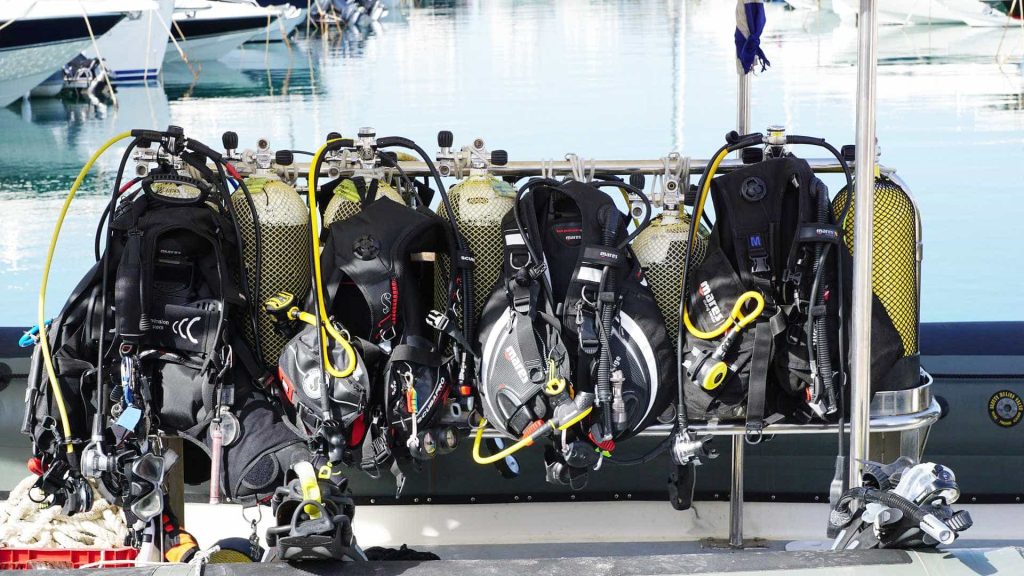
If you have your own dive equipment at home which is suitable for the kind of diving prevalent at your travel destination, I am a big fan of owning everything yourself.
Not only can you be sure the equipment is exactly how you want it to be, but it is also more cost-efficient than renting every time.
Last but not least, renting single pieces like regulators or BCDs is often almost as expensive as renting a full kit, so if you bother bringing any equipment, do it right. 😉
I also very much enjoy knowing who has previously breathed from my regulator, and finding comfortable rental fins and boots at my shoe size (47/13) is no fun at all.
The last option is to bring what you can and rent the items with the highest weight-per-euro/dollar ratio.
Let’s be honest. Packing an ADV-style BCD is no fun (go Backplate & Wing!!!), no matter which brand or size. Whether you own a small or extra-large one is only marginally different and will be annoying.
Therefore, I strongly believe that renting a cheap BCD is your best bet if you are on a tight weight budget with your luggage.
Second are regulators, which are very expensive to purchase and should never be in your suitcase. If you want to bring it, put it into your carry-on item so it does not get stolen or lost.
Again, I advise you to buy your own computer and ABC set, which can be used in any case, even if you are not even scuba diving the entire trip.
Mask , snorkel, and fins are simply the base equipment any diver should own, so why not bring it?
On average, a computer will cost about 10-20€ per day, so even if you only do 5-10 days of diving every year, you will save money after only your second trip.
One thing I rarely bring on trips is a drysuit , especially when taking a plane to get to the destination. It’s just so heavy and takes up a lot of space, I don’t think it is worth the hassle or the money I (don’t) save by bringing it myself.
I hope this scuba diving packing list helps you as much, as it has helped me through the years!
If you know anything that absolutely should go on here, as well, post it in the comments and I will make sure to include it asap.
Join the email list to get regular diving tips, tricks, insights, and news straight to your inbox!
Always dive with friends and happy bubbles. 😃
Make the most out of every dive
Join more than 21,300 readers on our email list for more tips & tricks! We send out one newsletter per week, every Wednesday.
Ultimate Liveaboard Packing List: What to Bring on a Liveaboard Dive Trip
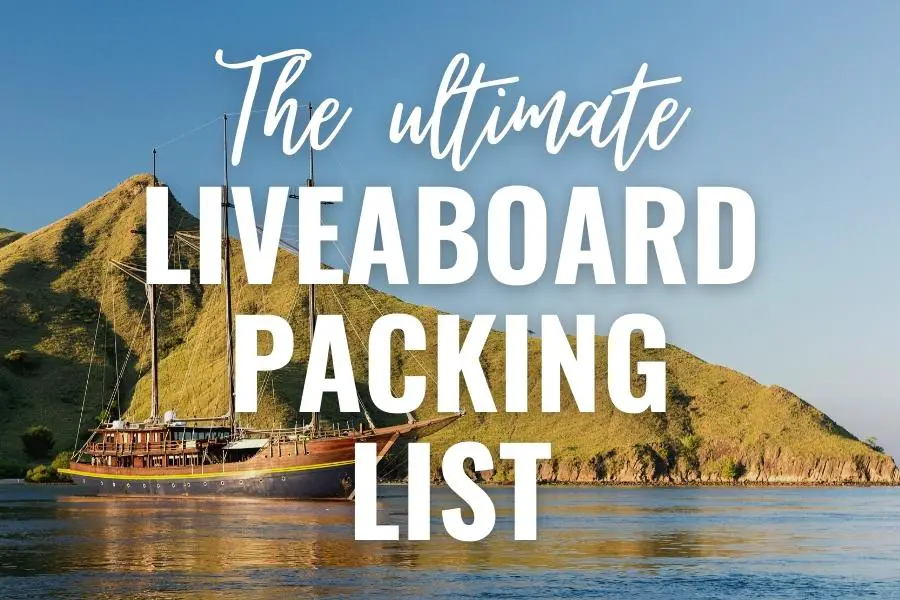
The links below may be affiliate links. If you shop through them, I’ll earn a commission at no additional cost to you. For full information, please see my disclaimer here.
Are you going on your first scuba liveaboard trip and have no idea what to bring? In this post I will share with you my liveaboard packing list.
You’ve probably booked your first liveaboard and you’re just about ready to go to your dream dive destination. Everything is pretty much perfect until you realize you still have to do some packing!
In my experience, packing for a liveaboard trip might be a bit different than packing for a regular dive holiday. On a liveaboard trip, you’ll most likely spend days at a time at sea and in very confined spaces so this is something you should consider.
If you find the idea of packing for a liveaboard trip daunting, don’t worry, I’ve got you!
I’ve done a liveaboard in the Great Barrier Reef and a liveaboard in Tubbataha Reefs , so I know a thing or two on what you should bring and what you should just leave at home.
Continue reading for some tips and suggestions on what you should pack for a scuba diving liveaboard holiday. I will go through different travel essentials and recommendations so you don’t feel overwhelmed or you don’t overpack!
Dive and travel documents
What to wear on a liveaboard, what toiletries and personal care products to bring on a liveaboard, scuba diving gear to bring for a liveaboard dive trip, underwater camera and electronic devices, bags and travel must-haves.
Passport – If you are traveling internationally, check your passport’s validity. As a general rule, your passport must be valid for another six months before you depart for international travel. I know divers who completely forgot to check their passport’s expiration date and they had to cancel the trip.
Visas- Double-check what the rules of entry are for the country you are visiting. Depending on your nationality, some may require you to apply for a visa before arrival. In some countries, vaccination cards or covid-19 testing might still be a requirement before entry. Arrange for these prior to departure.
Cash and Credit Cards – Find out what is the best way to pay in the destination you are heading.
Cash is still king and still the best way to pay for basic needs while traveling. Avoid carrying too much though but also remember that you will be heading to remote areas and sometimes underdeveloped countries. ATMs and money changers might be scarce or far in between.
Many places do not have credit card facilities and you may be asked to pay in cash for most things. Visa and MasterCard are mostly accepted. But in some countries or businesses, they may add a 3-5 % surcharge to cover banking fees.
Inform your bank that you are traveling abroad and will be using your card there on specific dates. This is to avoid your card from getting blocked.
You might also want to bring cash on your liveaboard for any additional expenses like your liquor consumption or to buy souvenirs.
If you’re happy with the service and experience, you can also tip the crew in cash. Ask the liveaboard what their recommendation or policy is on tipping.
Dive and travel insurance – Make sure to get one so you’re covered while traveling and diving. Some travel insurance policies will not cover diving accidents and some diving insurance policies will not cover travel emergencies.
Remember that for liveaboard destinations hospitals and emergency facilities may be scarce or hard to find. Getting dive and travel insurance can give you that extra peace of mind in case of an emergency. I personally use Divers Alert Network (DAN) .

You can also check SafetyWing . It is an international travel medical insurance that can cover you while you are outside your home. COVID-19 coverage is also included! Enter your details below to get a quotation.
Swimwear – Since you will be diving multiple for several days. I recommend packing at least two swimsuits. I hate wearing wet swimwear at the beginning of each day so I usually pack 3 to 4 sets of bikinis. This allows the suits to dry.
Between dives
Microfiber Poncho – I highly recommend wearing this to keep you warm after a dive. Ponchos are usually made with towel-like material so it will help dry off the salty water. It will also give you some protection from the wind chill.
Beach cover up or “sarong” – For ladies, a light cover-up can be useful to be worn between dives. The breathable and quick-drying material is perfect for tropical destinations. I like to bring a sarong as I find this versatile. It can be worn as a wrap around the torso, as a headcover from the sun or it can be used to lay down on while you’re working on a tan.
After diving
Regular clothes – If you are diving multiple times a day, you’ll most likely change into regular clothes only at the end of the day when all the dives are done.
I usually bring one change of clothes per day. But feel free to repeat outfits. I’ve seen divers wear the exact shirt for three days straight and no one really cares. As long as you have good hygiene and have terrible body odor, people won’t mind.
If you’re going on a 2-week liveaboard, it doesn’t make sense to take 14 different outfits so don’t worry about repeating outfits. Some liveaboard will also have laundry service.
Wearing shorts, shirts or tank tops is perfectly acceptable. Find out what the surface temperature is and dress appropriately.
I like to wear light beach dresses as I find them more comfortable. They do not take up much space compared to shirts and shorts.
Hoodie or light jacket – It gets a bit more chilly at night so you can wear a hoodie or jacket to stay warm. Cabins can also get too cold so this might come in handy.
Sleepwear- I bring one to two sets of sleepwear depending on the duration of the liveaboard.
Underwear- This is self-explanatory!
Flipflops/ slippers/ thongs- This is possibly the only footwear you’ll ever need while on a liveaboard.
Shoes/ Sandals – Once in a while I do pack a sturdier pair of sandals, rubber shoes, or sneakers depending on the itinerary.
Socks- If you bring closed shoes then bring extra socks as well. An extra pair is also handy for keeping your feet warm at night. When you are doing multiple dives, wearing socks can help protect your feet from getting blisters.
Accessories
Sunglasses- Bring eyewear with polarized lenses and UV protection. You will be staring out at sea most of the time and the glare from the sun can hurt your eyes.
Hat / Head scarf / neck buff- Useful to protect yourself from harmful rays of the sun. These breathable sun masks are great for your outdoor adventures.
Jewelry – Leave your expensive jewelry at home. I know some couples even leave their wedding rings and wear a silicon ring band instead.
Towels – Confirm with your liveaboard if they provide towels. If they don’t provide them, bring quick dry towels for saltwater and another for freshwater use. You can also take this cool microfiber dive map towel so you and your new liveaboard dive buddies can plan for your next dives.

Please consider getting toiletries made of sustainable materials to reduce plastic and the diminishing of our resources.
Read: 11 Tips for Sustainable Travel in the Philippines
Shampoo and Conditioner – most liveaboards provide this but if you’re particular I suggest taking your favorite hair product in smaller travel-sized bottles to save on space. I’m sure you will not need 1 Liter of shampoo for your 3-week trip.
I love taking my shampoo and conditioner bars. If you need some recommendations, here is a list of the best zero waste shampoos and conditioners .
Body soap – You will be living in close quarters with a lot of people so good hygiene is important.
Deodorant – You will be sweating a lot with all the physical activity so wear deodorant to avoid bad body odor.
Dental Care Kit – Pack your toothbrush, toothpaste, and even your floss and mouthwash if you want. Nobody wants bad breath and you gotta keep those smiles sparkling as you take selfies of your vacation!
Facial Skin Care Products – Whether it’s a two-step or ten-step regimen taking care of your skin should not go on vacation too. You’ll be exposed to the harmful rays of the sun so take your cleansers and moisturizers.
Lotion – exposure to sun and salt may leave your skin feeling dry so you need this to keep your skin moisturized. I personally like using coconut oil as it helps with my tan and it smells good!
Reef-safe sunscreen – To avoid damaging your skin and the reef, bring your own reef-safe sunscreen .
Hairbrush or comb + hair ties – Messy hair, don’t care? Remember that salt water can leave your hair damaged and in a tangled mess. Here are some tips on how to care for your hair when spending a day diving or on the beach.
Leave in Conditioner – Many divers recommend wearing leave-in conditioner to avoid hair damage. If you are looking for a product that cares for your hair and the ocean, you can check out Stream2Sea reef-safe leave-in conditioner .
Lip Balm – Did you know that you can get lip sun burn too? Bring lip balm with SPF protection to avoid sun damage on your lips
After-sun lotion- If you are prone to sunburn, bring some aloe to soothe your skin after extreme sun exposure.
Birth Control or Contraception – be a responsible adult and bring your own supply. Especially if you’re traveling solo, it’s very easy to hook up with someone on board. I have seen it happen after a couple of drinks!
Medicines and First Aid- Pack a small medicine/ emergency kit in your bag that has your preferred/ familiar brands of medicine.
Include in your first aid kit some waterproof bandaids and anti-bacterial creams in case you get cuts and scratches. Never expose open wounds to ocean water as it will get infected and make it worst. I once had to drink antibiotics and stay out of the water for a few days just to let an open wound heal.
Some people might have more sensitive stomachs than others so bring antimotility medicine for diarrhea or food poisoning. Allergy medicine and pain relievers are also good to bring.
Pack some motion sickness pills and other remedies that may help with seasickness .
Prescription medicine should be labeled properly. Bring extra just in case you have travel delays or you need to stay longer in the country.
While the liveaboard may have its own first aid kit, it might have a limited supply. They might also not have what you need and access to a pharmacy might be difficult when you are diving in remote areas.
Eyemasks and earplugs and sleeping pills – If you have trouble sleeping in new places, you will thank yourself for bringing these three things. These may also come in handy when you find yourself being roommates with a person who snores.
Sanitary napkins, tampons, or menstrual cup – I know we all hate it when our trip coincides with that time of the month but it shouldn’t stop us from having fun! You can still scuba dive while on your period .
Pack your own supply of tampons or pads even if it’s not that time of the month yet. You never know when your period decides to come early.
You might also consider switching to a menstrual cup as they’re more eco-friendly! I also find that they’re comfier to use than a pad or tampon especially while traveling.
For more feminine product recommendations, check out my post on eco-friendly menstrual products for a zero waste period .
For more eco-friendly travels, check out this article on what essentials to include in your Zero Waste Travel Kit .

Most liveaboards will have gear rental on board but so but if you will be bringing your own scuba diving kit here are some of the things you might want to bring with you for your liveaboard trip.
Exposure Suit – Ask your liveaboard what exposure suit they recommend you wear for the destination you will be visiting. I usually wear a 3mm suit for tropical weather diving.
Dive skins/ dive leggings / rash guards – when waters are a bit warmer I sometimes skip the wetsuit but still wear leggings and a rash guard to avoid any dangerous marine animals that may sting me. Many liveaboard locations are in remote areas and the last thing you’d want is to have a medical emergency from an animal sting.
This can also be good for sun protection if you don’t like wearing sunscreen.
Dive leggings and rash guards can serve as an extra layer of insulation. The silky fabric can help you get in and out of your wetsuit.
Check these posts: Best Scuba Diving Rash Guards for Women of Different Styles, Shapes, and Sizes Best Scuba Leggings: 10 Brands To Help You Look Good While Diving 9 Best Whale Shark Leggings For Your Active Lifestyle
Dive Computer – you will be doing multiple dives and having your own dive computer will help make sure you are diving within your limits. make sure batteries will last you for the entire dive.
BCD (Buoyancy Control Device)
Regulator Set
Fins (with boots)
Snorkel – Some destinations may require you to have snorkel attached to your mask during dives, so bring it. Some surface entry and exit might be difficult too so this can be useful in some situation.
Compass – I’ve done a self-guided dive on a liveaboard before and you’ll definitely need to know how to use one.
Weight Belt or Integrated Weight Pockets – liveaboards will provide you with the weights so just bring your weight belt or pockets.
Emergency Signal Devices – Anything can happen at sea. For instance, you can lose your dive buddy or need to do an emergency ascent. You can be swept away by a current and drift away from your dive boat. If you’re in remote locations, having your own safety signal devices might be the only thing that saves you during an emergency.
I usually carry a Delayed Surface Marker Buoys (DSMB) and a whistle . While others also carry a mirror that can bounce sunlight and be used as a signaling device. Some divers also bring a Nautilus Lifeline Marine GPS as an extra precaution.
Reef hook – Some destinations where currents are strong will allow you to use a reef hook. This dive accessory will allow you to hook yourself on a rock and tether yourself to avoid getting swept away. Some places may not allow this as it can damage a reef if used incorrectly.
Gloves – If you are diving in temperate waters, they might allow wearing gloves but in many areas, especially if it is a marine protected area, wearing gloves is prohibited. This is to discourage divers from touching the reef or holding marine life. Check with the liveaboard what the local policy is when it comes to wearing gloves.
Dive socks – these comfortable socks can be worn with your dive boots or full-foot fins to eliminate chafing and blisters especially if you are doing multiple dives a day. Check out these colorful dive socks that will make your dives more fun and enjoyable.
Dive hood – this can help keep you warm especially if you’re doing multiple dives.
Dive Light – If you have one take it and experience a night dive while on a liveaboard. If you do not have one, you should be able to rent one. If you need to purchase one before your trip, here are the 10 best dive lights for recreational divers .
Save-a-dive Kit – If you are not familiar with this, it is basically your bag of spare gear or parts. Some people suggest bringing extra fin straps, extra masks, extra o-rings, bungie cords, tie wraps and anything that may fix or “save a dive” when something goes wrong with your dive gear. I personally don’t carry one since I don’t mind renting.
Mask defog – You can bring your own but you can also just ask from the dive shop. They usually use liquid soap to defog masks. You can check out this Reef-safe defogger from Stream2Sea for an eco-friendly anti-fog solution.
Dive Knife or Line Cutter – Occasionally you might see fishing nets and lines underwater. These will come in handy when you need to rescue an animal from a ghost net. I carry an Aqualung Stainless Steel Blunt Tip Dive Knife.
Log book – Don’t forget to record your liveaboards experience in your logbook. In case you need to buy a logbook before your trip, here’s a list of the best dive log books .
Dry Bag – I recommend getting one as you will be going on a lot of boat rides and possibly some island hopping. This will keep your valuables dry and protected while in transit.
Here is the scuba equipment and dive gear I bring on my dive trip
My Scuba Diving Gear Regulator: Scubapro MK25 Evo , C300 and C200 2nd Stage BCD: Aqualung Axiom Mask: TUSA M-212 Freedom Ceos Snorkel: TUSA SP-170 Platina Hyperdry II Booties: Poseidon Pink Dive Boots Wetsuit: Seavenger Scuba Leggings: Ocean Spirit by Aurora Wetsuits (For a 10% discount, use Coupon Code: DIVERBLISS) Vest Hoodie: Scubapro Hybrid Hooded Vest Dive Watch: Suunto D4i Novo Dive Knife: Aqualung Blunt Tip Knife My Underwater Camera Gear Underwater Camera: Canon G7X Mark II Underwater Camera Housing: Fantasea FG7XII Video Lights: Big Blue AL1200XP Dive Insurance Divers Alert Network (DAN)

Mobile phone – While you might want to go on a digital detox, having your mobile phone will still come in handy for taking photos and staying connected with the resort of the world, even in the most remote areas. Make sure that your plan covers roaming or get a local SIM card if you need to.
Invest in a protective and waterproof case too.
Underwater camera- With the beautiful reefs and marine life you’ll encounter, you’re going to wish you had a camera underwater!
If you’re just starting out and not sure what camera to bring, here are my top recommendations for the best scuba diving camera for beginners . Make sure the camera you get can go down at a depth that matches the level of diving you are doing.
I personally bring my Canon G7X Mark II for my travels and diving. I highly recommend this underwater camera since it’s compact and affordable. I’ve written a Canon G7X Mark II review for you to check out if you’re looking to buy a camera before your trip.
I also use a GoPro Hero9 and GoPro underwater housing .
Don’t forget to include your underwater camera accessories:
- camera lenses
- camera tray
- arms and clamps
- video lights
Charger and Extra Batteries – You’d be surprised by the number of people who have actually forgotten these and left them charging at home! Consider getting extra batteries cause you never know how much time you have to recharge them.
Memory Cards- Don’t put all your photos on one card. I take several memory cards as I have experienced losing some and even having the card corrupted… Bye-bye photos of your best vacation ever!
Laptop or smart pad- If you’re bringing your camera, a laptop or smart pad can be used to back up your files and review images you had taken. You can also fill it with your favorite music, ebooks, and games to keep you entertained.
Headphones – If you like some alone time, these will come very useful, especially in a diver-filled boat! Find a noise canceling headphones to block out any disturbance. This is perfect for anyone who doesn’t feel like socializing 24/7.
Drone – These are great to capture aerial shots of your dream destination. It will give you and others a rare glimpse of where you went diving. Some places might require you to get a permit for this ahead of time, so check with your liveaboard if this is allowed and if there are fees involved.
Power bank – While your liveaboard will have outlets, power banks can come in handy while you’re in transit. You can be traveling several hours just from one place to another and it’s always a good idea to have a portable charger with you.
Power Strip- If you have a lot of gadgets that need re-charging, bring a power strip for convenience.
Travel Adaptor/ Converter – Ask the liveaboard what outlets they have on board. You might need to bring a travel adapter or a converter for your gadgets.

Dive Luggage – Bag choice really depends on what kind of travel you are doing and the difficulty of accessing the destination. Remember that you might need to ride tiny boats, buses, trikes, and jeeps to get to the port where your liveaboard is docked, and having wheeled luggage might actually be more difficult to transport.
Also, consider that there might not be enough space on your liveaboard vessel and in this case a dive duffle bag works best. When I went on a liveaboard in the Great Barrier Reef , they asked us to leave our big suitcases in their dive shop and only bring what we need for 3 days of diving.
Packing cubes – these will help you keep your things organized
Entertainment – If you don’t intend to bring gadgets with you, bring a book to read or something to keep you entertained during downtime.
Refillable Water Bottle – You need to stay hydrated while you’re diving and having a refillable water bottle can help you keep track of the amount of water you are consuming. I bring mine wherever I go. These insulated flasks from Waterlust even have a cute ocean-inspired design that divers will love.
Snacks – While you will be well fed on your liveaboard, it’s still good to bring your own favorite snack or candy to munch on. This is great especially if you tend to get homesick and just want something that is not just yummy but also comforting. Snacks from your home country can also be great to be shared with everyone divers and crew included.
Positive mindset – Leave your stress and worries behind and don’t bring your negative vibes on board. You are most likely to have a good time if you bring an open mind and heart along with you. Have fun, create memories and make new friends.
Pin this for later!
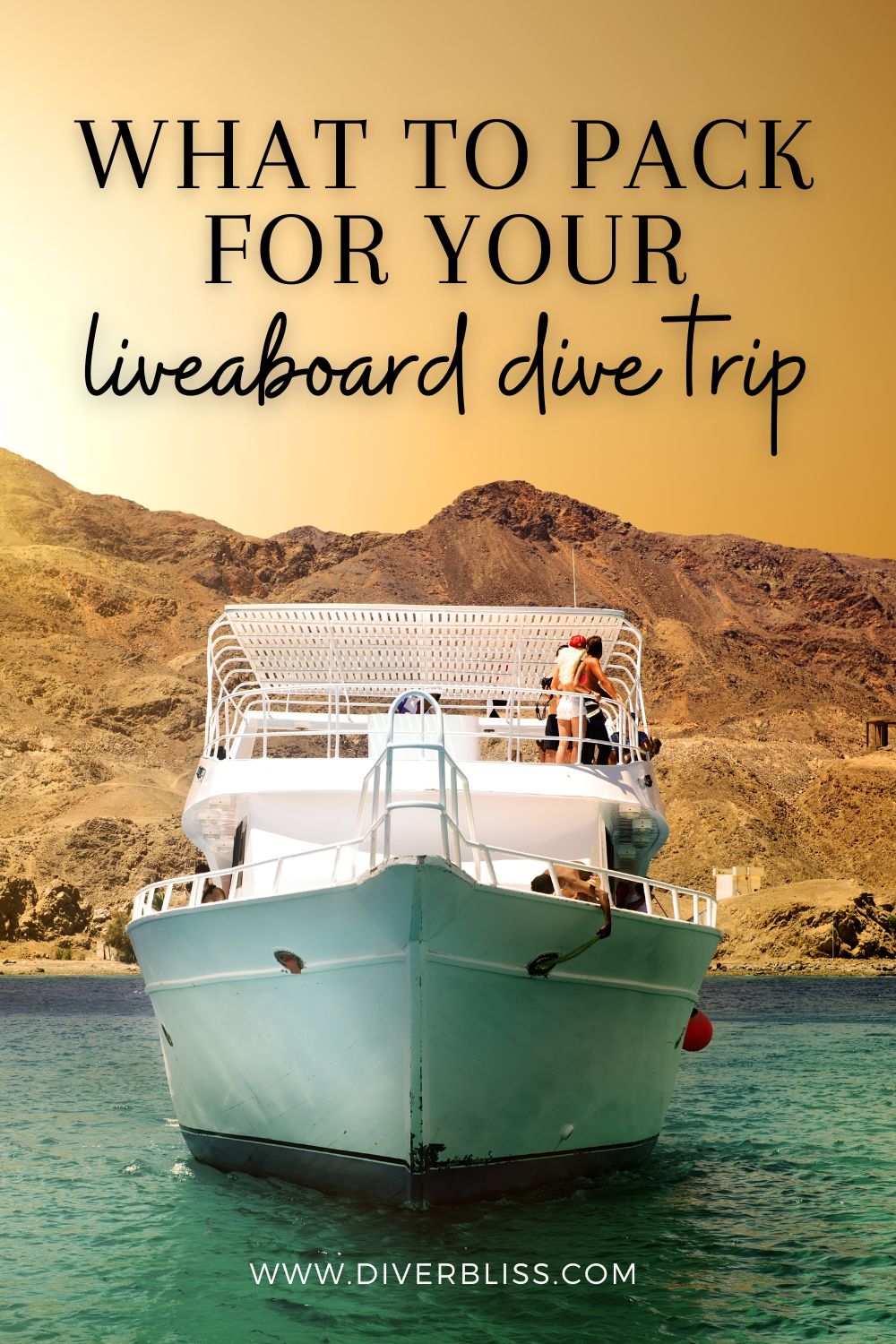
Are there items that I forgot to include but should be on this liveaboard packing list? Leave a comment below!
The links above may be affiliate links. If you shop through them, I’ll earn a commission at no additional cost to you. For full information, please see my disclaimer here.
About The Author
Related Posts
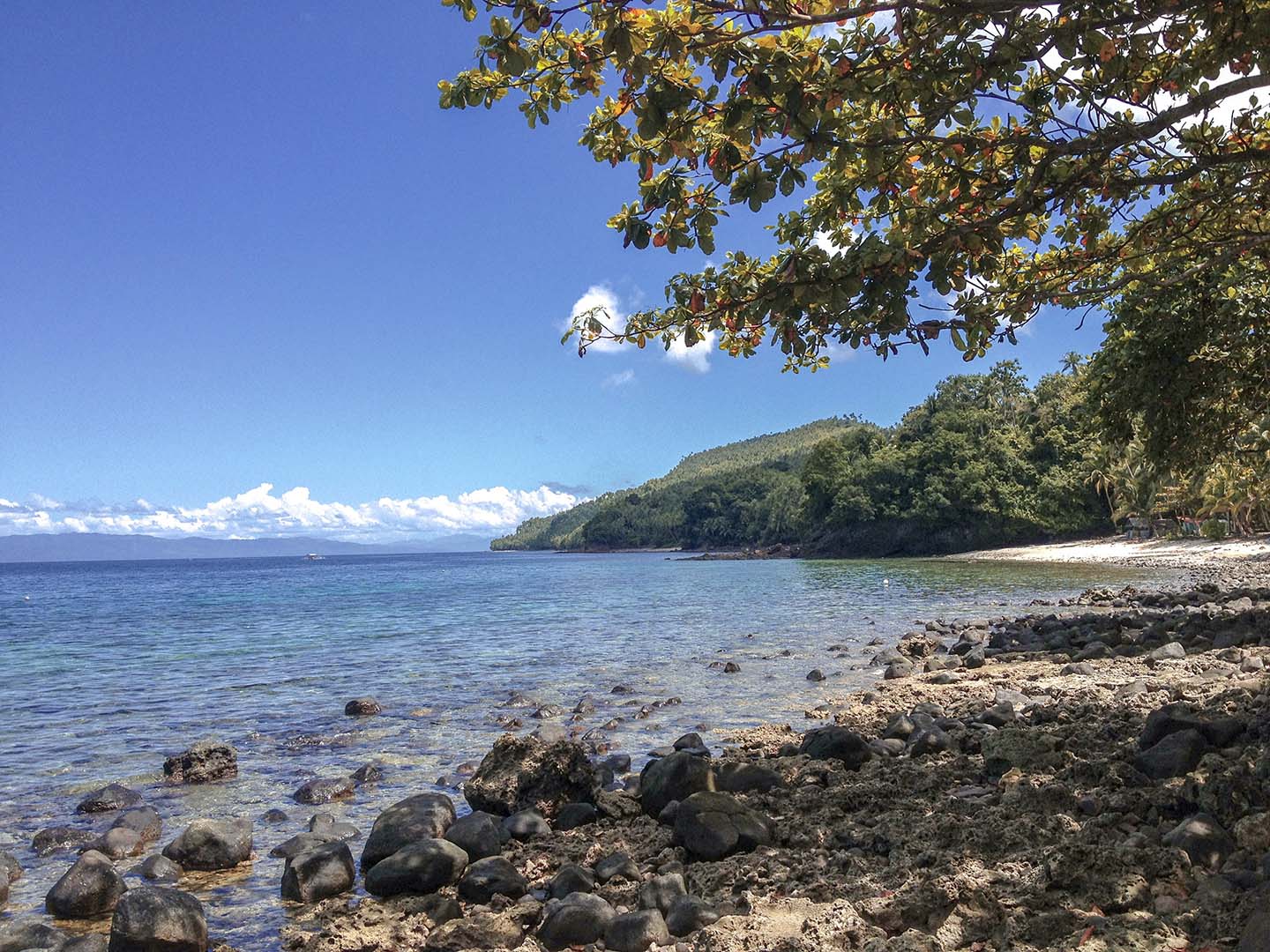
Coral Cay Conservation: Scuba Diving Scholarship in the Philippines
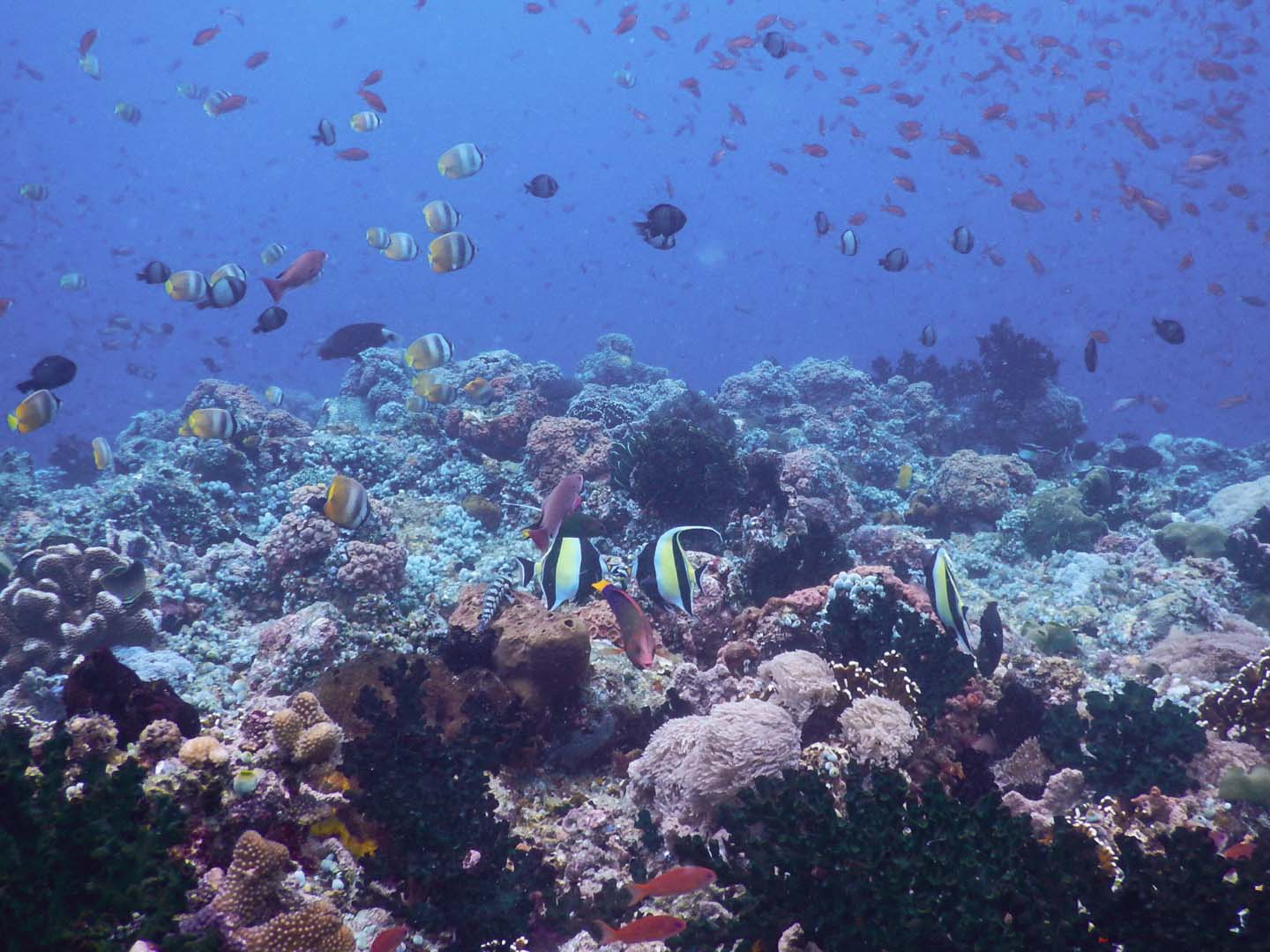
Scuba Diving in Anilao, Batangas, Philippines: Complete Guide
Scuba Diving Vacation Packing List
- Visas (if required)
- Photocopy of essential travel documents
- Vaccination booklet with updated stamps
- Plane tickets (printed and electronic)
- Hotel booking confirmation
- Car rental confirmation
- Pre-paid dive vouchers
- Credit cards (1-2)
- ATM or Debit Card
- Prescription medications (bring a few extra in case of delays)
- Glasses / Contacts (bring a spare pair in case of loss or breakage)
*Keep these in your carry-on.
Must-have to dive
- Certification and specialty cards (nitrox, deep, night, wreck)
- Medical release (if needed)
- Dan or another dive insurance card
- Pre-filled waivers (to save time)
- Dive computer
- Logbook (not essential but fun to note down what you saw during your dives)
- Prescription mask
*Pack these in your carry-on.
- Regulator, gauge, octo
- Exposure suit (appropriate for your destination)
- Spare mask (a must if you need a prescription mask)
- Dive gloves (if permitted)
- DRYFOB waterproof car key container
- Safety sausage and reel
- Security devices (whistle, mirrors)
- Nautilus GPS Beacon (optional, but a good idea and be sure to program it for your location)
- Dive lights, batteries and chargers
- Dive knife (if allowed)
- Save-a-dive kit
- Hangers (optional)
Dive camera and accessories
- Camera and housing
- Strobe and lights
- Batteries and chargers (place lithium batteries in carry-on)
- Extra memory cards
- Spare O-rings and silicone lube
- Underwater housing for iPhone
See our post: Protecting Expensive and Fragile Equipment While Traveling
Electronics
- Phone and charger
- Laptop or iPad (to download your photos)
- Power adapter (when necessary/ check voltage)
- Power strip (to charge all your devices)
- Swimsuits and cover-ups
- Rash guards
- Shirts / T-Shirts / Tops
- Pants / Shorts
- Skirts / Dresses
- Underwear / Bras
- Sandals or sneakers
- Lightweight fleece or hoody
Personal care
- Toiletries (toothbrush, toothpaste, floss, deodorant, etc.)
- Lip balm with sunscreen
- Dental night guard
- Reef safe shampoo and conditioner
- Brush or comb
- Razor / Shaver
- Reef safe sunscreen (broad spectrum, SPF 15 or higher)
- After sun gel or lotion
- Insect repellent (TSA approved size and pack in carry-on)
- Anti-bacterial gel or wipes
- Extra face masks
- Facial tissue (3-4 small packs)
- Nail file / Clippers
- Make-up (optional)
- Hairdryer (optional)
- Flat iron (optional)
Emergency First Aid Kit
- Motion sickness medication (Dramamine, Gravol)
- Swimmer’s ear drops
- Antibiotic ointment (Polysporin, Neosporin)
- Cortisone cream
- Band-Aids (regular and waterproof)
- Anti-itch cream for insect bites (After Bite, Benadryl)
- Pain relievers (Advil, Tylenol, Aspirin)
- Antihistamine (Benadryl, Claritin)
- Antacid tablets (Tums, Rolaids, Pepto-Bismol)
- Anti-diarrhea medication (Imodium, Pepto-Bismol)
- Surgical gloves and masks
- Cold medicine
- Manicure size scissors (only in checked luggage)
*Fit everything in a small pouch and bring only enough for immediate usage. If more is needed, most of these items can be found at local pharmacies.
Other items
- Arm sleeves UV sun protection
- Microfiber towel
- Beach bag (optional, but can also double up as a daypack)
- Raincoat / Umbrella
- Reading material
- Fish identification book
Download your printable Scuba Diving Vacation Packing List

You may like:
- How and What to Pack
- How to Travel Only with a Carry-on
- 12 Tips for Surviving Long International Flights
Types of Scuba Diving
Gear and Equipment List
Mastering Basic Diving Skills
Essential Safety Tips
What to Know About Liveaboard Trips
Guide to Night Diving
How to Get Certified to Scuba Dive
Certification Programs
Cheapest Places to Get Certified
Best Diving Destinations in the World
Shore Diving Destinations
Diving in Aquariums
Underwater Museums
Dive Watches
Diving Fins
Scuba Masks
Underwater Cameras

Planning a Scuba Diving Trip: The Complete Guide
:max_bytes(150000):strip_icc():format(webp)/DSC00412-5b73daf7c9e77c0057ca2198.jpg)
Whether you’re looking forward to a weekend getaway to your nearest coast or a once-in-a-lifetime vacation on the other side of the world, careful planning is the key to a successful scuba diving trip. Follow our simple steps to ensure that you choose the destination that best suits your experience and interests and ensure that everything runs smoothly once you get there.
Choosing Where to Go
We all know how important location is for every kind of adventure, and underwater ones are no exception. There are many different factors to consider when choosing your next diving destination .
First, consider your budget. How much are you willing to spend traveling to your vacation spot, and what’s the cost of day-to-day living in the destination? For example, flights to Thailand from the United States are more expensive than a quick jaunt down to the Caribbean. Still, accommodation, food, dive equipment rentals, boat charters, and dive courses are considerably cheaper. For this reason, be sure to consider every expense when making a decision based on cost.
Next, decide how long you want to spend on your next diving adventure. If the answer is just a few days, that obviously limits your options no matter the size of your budget. When you can take time off is also important. If you are restricted to a certain time of year, you’ll want to look at the dive destinations that offer the best weather and water conditions at that time. Many popular locations (especially tropical ones) are very seasonal when it comes to prime diving time.
Dive Conditions
If your options haven’t already been narrowed down by budget and timing, the next factor to consider is the kind of diving you would like to do. Do you prefer balmy water temperatures and crystal clear visibility for underwater photography ? Are you aching to try your hand at ice diving? Altitude diving? Or maybe you want to explore historic wrecks? Certain bucket-list marine animals are only found in specific locations. The type of diving that you want to do will impact your destination options. Your skill level can also affect your options. Some dive destinations are notorious for deep dive sites and strong currents, making them off-limits to beginner divers.
Specific Dive Destinations
Need some inspiration? We've rounded up some of the best dive destinations for specific interests.
Beginner Diving
- Florida Keys , U.S.: The Florida Keys stand out for the beginner-friendly conditions (including warm water temperatures, great visibility, and limited current) and abundance of rewarding shallow sites perfect for open water training.
- Koh Tao , Thailand: Koh Tao is also well-suited to beginner divers in forgiving conditions and a wealth of shallow yet beautiful dive sites. It also has many dive centers to choose from and some of the cheapest rates in the world for entry-level scuba courses.
- Cozumel, Mexico: Cozumel spoils beginner divers with various dive sites within the required depth limit, all of them teeming with marine life. Courses are affordable, and there are also more challenging sites for those that want to progress onto an advanced course.
Wreck Diving
- Chuuk Lagoon, Micronesia: This lagoon was used as a Japanese naval base during World War II. In 1943, Operation Hailstone was launched by Americans, sending more than 50 ships and 250 planes to a watery grave.
- Graveyard of the Atlantic, U.S.: This stretch of treacherous North Carolina coastline is named for the more than 1,000 shipwrecks found between Currituck Beach and Cape Fear.
- Coron Bay, Philippines: Coron Bay is the site of another sunken Japanese supply fleet sent to the bottom during a bombing attack in 1944.
Shark Diving
- Tiger Beach, The Bahamas: Tiger Beach is a famous underwater amphitheater defined by its white sand floor, crystal clear visibility, and up-close shark encounters. Top species include tiger sharks, giant hammerheads, and Caribbean reef sharks.
- Aliwal Shoal, South Africa: Enjoy baited shark dives with oceanic blacktip sharks, with other species (ranging from duskies to bull sharks and great whites) often coming to visit. Sandtiger sharks are spotted on the reef in the winter months.
- Beqa Lagoon, Fiji: Beqa Lagoon is home to eight different shark species. It is most famous for close encounters with super-sized bull sharks, many of which gather to gestate in the lagoon's warm, clear waters.
Muck Diving
- Mabul, Malaysia: This dive destination off the coast of Borneo famous for its muck diving opportunities. Expect an astonishing variety of macro critters, from ribbon eels and mandarin fish to tiny pygmy seahorses.
- Lembeh, Indonesia: This is a renowned macro photographer's destination, thanks to its black volcanic sand, which provides the perfect backdrop for many colorful macro species.
Temperate Diving
- Silfra Fissure, Iceland: Located in Thingvellir National Park , a UNESCO World Heritage Site, Silfra Fissure is the place to visit if you've ever wanted to dive between two tectonic plates in the world's clearest glacial meltwater.
- Channel Islands , U.S.: This national park offers fantastic opportunities for boat-based diving amongst giant kelp forests, where cold-water species including sea lions and bat rays thrive.
- Scapa Flow, Scotland: This is the ultimate wreck-diving destination for drysuit divers. At the end of the First World War, 74 German naval ships were intentionally scuttled here to prevent them from passing into British hands.
Planning and Preparing for Your Trip
Once you have decided on your dream destination, there are many elements to consider in the planning phase. First are the practicalities: How are you going to get there? If you’ll be flying, is there an airline that stands out for its generous luggage allowance (so that you can pack more scuba gear without worrying about overweight fees)? If driving is possible, how long will it take? Will you need to plan overnight stops along the way? Do you need any special paperwork for border crossings?
The next step is to book your accommodation. It often makes sense to choose a hotel with an attached dive center or a hotel that offers a shuttle service to a nearby dive shop. Alternatively, consider combining your diving and sleeping even more seamlessly with a liveaboard dive trip . These are particularly popular (and often quite economical) in Egypt, Thailand, and The Bahamas. You’ll be able to fit in more dive time and can enjoy the luxury of living, dining, and sleeping on the boat in between underwater sessions.
If you plan to take your own gear with you, you’ll need to make sure that everything is working properly. That means checking the seals and valves on your buoyancy control device (BCD), ensuring your low-pressure inflator hose connects securely, having your regulators serviced, and checking the straps on your mask and fins. Taking a camera with you? Charge your batteries, grease your O-rings, and be sure there’s plenty of space on the memory card. If you plan on renting equipment, make sure you know where you’ll be renting from and consider booking the correct sizes in advance.
Lastly, don’t forget the paperwork. In addition to flight tickets, proof of accommodation, and proof of transfer reservations, be sure to check whether you need a visa for your destination. Do this well in advance because although some countries allow you to purchase a visa on arrival, others may require you to apply at an embassy or consulate in your home country. Some destinations (especially those within a national park or marine protected area) also require you to purchase a dive permit, while others require proof of certain vaccinations.
Choosing a Tour Company or Dive Center
Unless you have all of your own gear, a buddy to dive with, sufficient knowledge of your intended dive site, and a way to get to it independently, you’re going to need the services of a dive center, liveaboard, or dedicated diving tour company. Choose the right one, and you should be able to arrange dive courses, fun dives, equipment rental, and transport as required. But how do you know which is the best one for you?
The first step is usually to narrow centers down to those affiliated with your chosen training organization (i.e., PADI, SSI, NAUI, or one of the other main programs). This is true whether you’re already certified or planning to become so. This way, you can be sure that your qualification will be accepted and that the instructors and/or dive guides dive according to the practices you’re familiar with. Next, compare pricing, availability for your chosen dates, and the diversity of courses, dive sites, and specialty diving experiences offered.
Finally, it’s an excellent idea to check out the experience of previous guests by reading reviews. That way, you’ll be able to read up-to-date opinions on crucial elements such as customer service (including the competency of the center’s instructors, the knowledge and enthusiasm of its dive guides, and the friendliness of its shop-based staff). You’ll also be able to find out more about the quality of the dive gear available to rent, how convenient the shop is for reaching the dive sites, and more.
Image Source / Stuart Westmorland / Getty Images
What to Pack
Your packing list and precise clothing requirements will depend on your destination's topside weather and underwater conditions. Nevertheless, here’s our comprehensive overview of the essentials that you should consider for every trip. Remember that if you don’t have your own scuba gear, you will need to investigate where, how, and how much it costs to rent on arrival.
- Passport or identification
- Wallet or purse with cash and credit cards
- Dive certification card
- Diving logbook
- Dive computer
- Mask and snorkel
- Weight belt or integrated pockets
- Weights (if traveling locally)
- Air Cylinder (if traveling locally)
- Dive boots and/or socks
- Dive gloves and/or hood
- Spares kit (O-rings, mask strap, fin straps)
- Surface marker buoy/delayed surface marker buoy and reel (for drift diving)
- Primary and backup torches (for night diving)
- Underwater camera, including strobes, housing, battery charger, and cables
- Marine life identification book
- Mesh bag for wet gear
- Warm clothing
- Waterproof clothing
- Clothing for other activities/going out
- Beach towel
- Comfortable shoes
- Sun protection (sunglasses, sunscreen, sunhat)
- Insect repellent
- Money belt
- First aid kit
- Seasickness medication
- Prescription medications
- Toiletries and hygiene products
- Language phrasebook
Important Safety Considerations
A scuba diving trip should be memorable for all the right reasons, which is why it’s important to consider your safety both on land and in the water.
- Once you have chosen a dive destination, be sure to check with your doctor whether you will require any vaccinations. For some countries, proof of certain vaccinations is an entry requirement; it’s simply the sensible thing to do for others. If you’re headed to a malaria area , enquire about the safest prophylactics to use while diving.
- For mosquito-borne diseases that can’t be medicated against, wearing insect repellent and long-sleeved clothing is the best way to avoid infection. You should also determine whether the local tap water is safe to drink and if any specific foods are best avoided. Don’t forget to stock up on any prescription medications and to carry a doctor’s letter to prevent any issues at customs. If you have any preexisting or temporary medical conditions that could affect your ability to dive safely, make sure to get a doctor’s written approval to dive before departure.
- Before you book your trip, check whether there are any travel advisories in place for your destination. These are issued for everything from health concerns to terrorism and often warn against regions or cities that are particularly unsafe. Always book accommodation in a safe neighborhood, keep your cash in several different, well-concealed stashes, and make copies of your passport and visa before traveling.
- Travel insurance is essential, as is checking that your policy covers you for diving specifically. Look at taking out insurance with the Divers Alert Network (DAN) for the most comprehensive coverage. Other diving-related safety precautions include enrolling in a refresher course to ensure that life-saving skills (from gear maintenance to safe ascent rates and air supply management) are foremost in your mind.
The World’s Best Scuba Diving Destinations
The 5 Best Scuba Diving Certification Programs
A Complete Gear and Equipment List for Scuba Diving
Snorkeling in the Caribbean: Off the Shore or Off a Boat
Every Type of Scuba Diving Explained
How to Plan For a New Adventure in Scuba Diving
Where to Snorkel and Dive in the Maldives
7 of the Best Dive Destinations in South Africa
Everything to Know About Liveaboard Dive Trips
Scuba Diving in Central America: Top Dive Destinations
8 of the Best Scuba Diving Destinations in Africa
Scuba Diving in Tofo Beach, Mozambique: The Complete Guide
6 of the World's Cheapest Places to Get Scuba Certified
The Best Seaweed-Free Beaches in Mexico
10 Essential Safety Tips All Scuba Divers Should Know
The 9 Best Scuba Diving Sites in the Seychelles

What to Pack for a Liveaboard – Ultimate Scuba Packing List
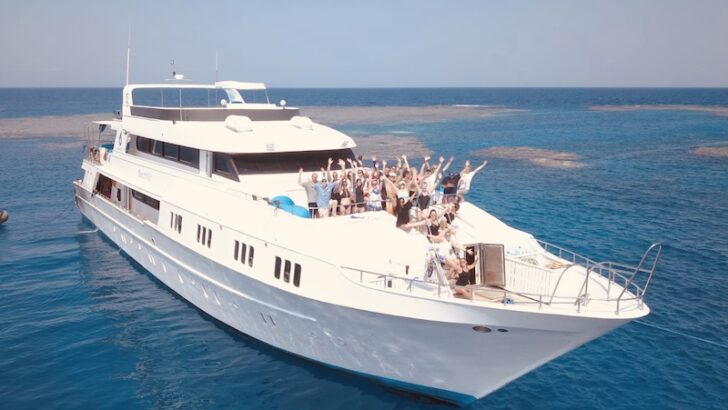
You’ve finally booked that dream scuba adventure, and now you’re left wondering what should I pack for a liveaboard dive? We’re here to run through the liveaboard essentials with our full scuba diving packing list.
From dive equipment to what clothing to pack – as well as what to leave behind – this is your ultimate liveaboard diving packing list. We’ve also included a handy liveaboard packing checklist at the end of this post which you can save to tick off as you pack!
Looking at booking a liveaboard trip?
Take a look at over 280 all over the world here
Documents & Insurance
You won’t get far without your travel documents, so these should come top of your liveaboard diving packing list. Ensure that you have your passport, visa (if required), flight tickets, travel itineraries, tickets for any transfer arrangements, and contact numbers for any operators you’re using along the way.
Whilst most of these can be presented as digital tickets on your smartphone nowadays, it’s worth carrying physical back-ups in case of technical difficulties.
Local Currency
Although liveaboards are mostly all inclusive, you’ll still want to transfer some local currency ahead of your trip. This will be needed for your land-based days before embarking and after you return, as well as for tipping your hard working crew.
Travel and Dive Insurance
Ensure you have travel insurance and dive insurance arranged ahead of your trip, and remember to carry the details of these policies. DAN is relied on by divers worldwide to provide assistance in dive emergencies.
DiveAssure offers a specific Liveaboard Rider which can be added on to their policies to cover a number of unique scenarios which would not be covered by regular travel insurance. GTS Membership Card holders receive 5% off DiveAssure policies.
Certification Cards and Dive Log
Many scuba liveaboards have minimum certification requirements, and some may ask for proof of a minimum number of logged dives . Make sure you take your dive certification cards – our Dive Cert Card Holder is perfect for keeping them organised, and you can even match it to your “Going Diving” Passport Cover!
Pack your log book to ensure you can prove your dive experience, and make sure you’ve got plenty of spare pages (or a new dive log book) for all the dives you’ll complete on your liveaboard.
What equipment do I need for a liveaboard?
When you’re heading on a boat trip specifically to go scuba diving, it should come as no surprise that dive gear will take up the majority of your packing space. Some liveaboards will have rental equipment available, but it’s advisable to have your own scuba equipment.
If you do have your own kit, there would be nothing worse than heading out on your checkout dive to discover an issue with your gear. We highly recommend getting your dive equipment serviced before your trip!
Exposure Protection
Choose your exposure suit based on the conditions in the location you’re diving in. Your liveaboard provider should be able to help you with this. Remember that completing multiple dives across many days means that you may feel the cold more than you normally do, so consider a thicker exposure suit than you might choose if you were just diving for one day.
Base Layers
Rash vests, leggings, and dive skins will be your best friends when you’re constantly getting in and out of your wetsuit. Consider bringing along multiple base layers so that you have something dry to change into for consecutive dives – this will go a long way towards maintaining your body temperature.
GTS Loves: the ocean-inspired prints and fundraising efforts of Waterlust .
Exposure Accessories
Don’t forget your dive boots, and consider packing gloves and a hood if it’s appropriate for the water temperature. Some divers carry two hoods to have a dry one to change into.
If you’re shopping for a new BCD ahead of a liveaboard trip, investigate the option of a backplate and wing setup or look into lightweight travel BCD options .
Your regulator set is another area which you can shave some weight off when packing for a dive liveaboard. Regs are a lot lighter than they used to be, with many specifically designed with travel in mind. GTS loves: the small frame and sleek look of the Apeks XL4+.
If there’s one piece of equipment that can make a dive miserable, it’s an ill-fitting mask. Find a mask which suits your face, and consider packing a spare one in case of a strap failure. Don’t forget to accessorise with a GTS mask strap!
For consecutive days diving, you’ll want to opt for boots and open heeled fins rather than full foot fins. Although you can find lighter weight fins, this may be a piece of equipment which you want to be heavier if you need a more forceful fin for diving in strong currents.
Check out our community favourites here.
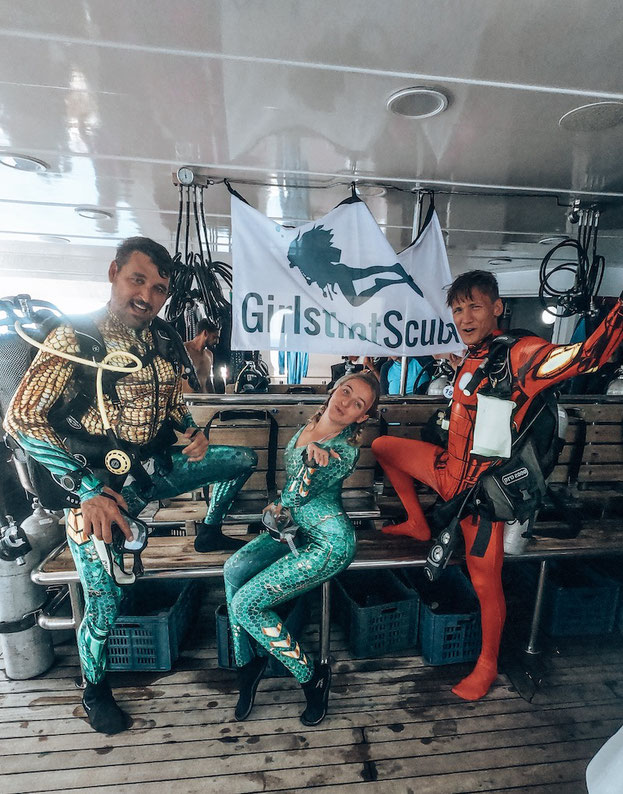
Dive Computer
An intuitive and easy to read dive computer will make your liveaboard dives much more enjoyable. GTS loves: the Suunto D5 .
Most liveaboards will offer some night dives in their schedule, so it’s advisable to have your own dive light to ensure you don’t miss out on the fun. GTS loves: the Apeks Luna Mini Dive Torch.
Many liveaboards require you to carry your own SMB or DSMB , whether as a precaution in case of separation from the group, or because divers often dive independently without a guide.
Pack one which can be seen in the conditions you’ll be diving in ( ours is bright pink and is visible in nearly all conditions), and seek out training to ensure you know how to use it ahead of your trip.
Save a Dive Kit
Whilst the boat will carry some spares, it can be helpful to have your own in a pinch. You never know when spare o-rings, port plugs, a multi-tool, silicone grease, or a spare fin strap will come in handy. Even if you don’t use them yourself, you’ll certainly be popular on the boat if you can save someone else’s dive! Read more about what to put in a save a dive kit .
Interested to see what a liveaboard looks like inside?
How much clothing do you need for a liveaboard?
When you’re spending so much time underwater it’s not worth wasting precious packing space with lots of clothing options. Not only is your packing space limited, boats also have minimal space available on board.
Organisation
Packing cubes can be beneficial both for organising inside your bag and for keeping things tidy on the boat. Many divers recommend carrying pegs, clips or a travel clothesline for hanging clothes and swimwear to dry.
Warm Clothes
Even if you’re packing for a liveaboard in a tropical destination, you’ll want warmer clothes than you’d think. Your core body temperature will drop after completing multiple dives repetitively for a number of days, and the AC on boats can often be cold.
Hoodies and sweatshirts are a must, as well as jogging bottoms/sweatpants. Keeping your head and feet warm is a great way to keep your overall body temperature up, so pack a toasty GTS beanie (we also have nudibranch and whale shark embroidered beanies !) and a few pairs of warm socks, too.
Surface Interval Clothing
Beyond the warm clothing, a few pairs of shorts (or a pair of jeans or leggings, location dependent) and a couple of t-shirts should be enough to see you through your trip.
Swimwear and Boat Layers
Swimwear doesn’t take up much space, so opt for a few extra bikinis instead of that snazzy dress that you definitely won’t wear in the evenings. You’ll be thankful to have a dry swimsuit to change into between dives.
It’s also helpful to have layers to protect you from the elements during your surface intervals – our GTS changing robe gets you dry and gives you somewhere to change into the aforementioned dry swimwear! The Fourth Element Storm Poncho is a great option if weather conditions are changeable.
Themed Outfits
Whilst you won’t need a high fashion outfit for every night at dinner, do check for any themed nights on board – some boats will have a specific evening for you to break out your fun shirts or fancy dress.
You’ll be spending most of your time in your dive booties and many liveaboards don’t allow shoes, so your footwear is only really needed for getting on and off the boat. Check to see if your itinerary offers any land-based excursions, though, as a pair of sturdy walking trainers may come in handy.
Finally, don’t forget your towel – microfibre travel options are a great space saver, and it’s worth having one towel for diving and another for showering.

Toiletries and Medical Supplies
Much like your clothing, you should aim to keep toiletries minimal when packing for a scuba liveaboard due to limited space.
Solid Products and Reef Safe Sunscreen
Choosing solid products in a bar form – such as shampoo and body soap – can help your space saving efforts (as well as helping to save the environment by being a plastic free choice).
When it comes to planet friendly options, ensure you’re choosing reef safe options such as Stream2Sea ’s reef safe sunscreen.
Menstrual Products
If you’re someone who experiences periods, choosing a reusable option for your menstrual products is another way to minimise your packing. Menstrual cups are a brilliant option for scuba divers, and we now have our very own GTS menstrual cup available!
Other menstrual product options for scuba divers can be found in our full guide to periods and scuba diving .
First Aid Kit and Medication
As with any travel, a small first aid or medical kit could come in handy. Stock up on your seasickness drug of choice, painkillers, and plastic-free plasters, and pack back-ups of any prescription medication you may need.
Camera Equipment for Liveaboards
You’ll want to capture memories from your liveaboard dives, so make sure to include your underwater camera housing and all of the accessories. Whether it’s quick snaps with a GoPro or you have a more sophisticated setup, you’ll be thankful if you pack a second battery and memory card to be able to interchange between dives. Double check that you’ve got all charging cables, too.
Entertainment and Other
Although you’ll be spending a lot of time in the water, there will also be plenty of downtime whilst cruising between dive sites.
Pack your e-reader or a few ocean themed books to keep you occupied (check out our Girls that Scuba Book Club if you’re in need of some book-spiration).
Devices and Downloads
Internet connection can often be tricky onboard, so if you’re not into books you might want to pre download some viewing material or ocean podcasts ahead of time. Headphones are a must to be respectful to your fellow guests, and some divers like to pack ear plugs in case of snoring bunk mates or noisy boat engines during night crossings.
Whatever device you’re watching or listening on, bring long charging cables if you can as power sockets may not always be in a convenient location. Power banks can also be useful for the same reason. Most charging will have to be done whilst you’re with your devices, though – leaving devices charging unattended can pose a fire risk.
Miscellaneous
Sunglasses are a must for any liveaboard trip, and our handy sunglasses lanyard is an essential to make sure your glasses don’t end up overboard when you’re peering out at the marine life.
Finally, remember to pack a refillable water bottle to minimise plastic waste, and perhaps a reusable coffee cup for warming up between dives.
Liveaboard Packing Checklist
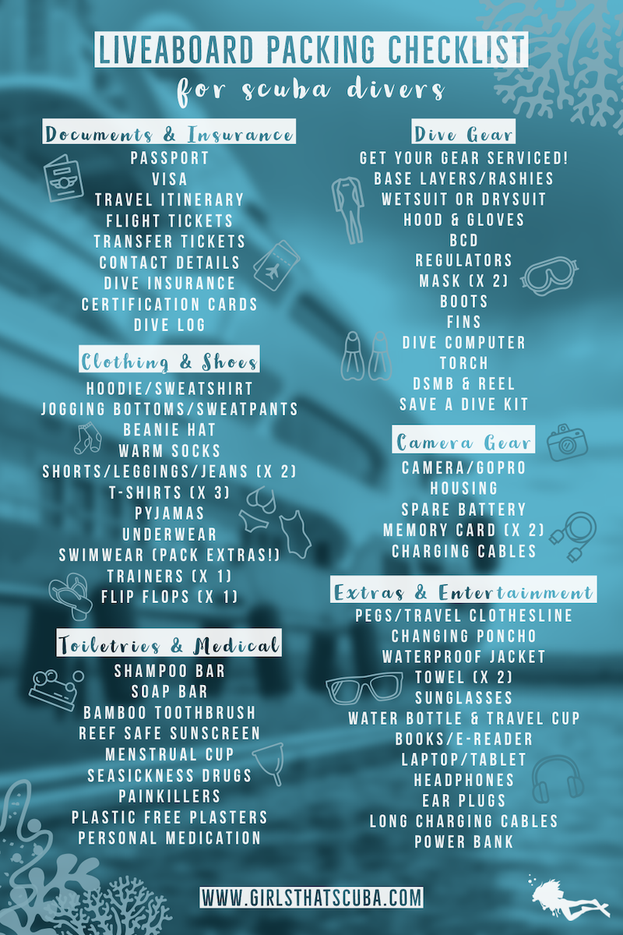
What liveaboard essentials can you not travel without? Let us know in the comments, share in the Girls that Scuba Facebook group, or tag us in your liveaboard packing stories on Instagram!
Deep Water Happy
- CRUISING & DIVING
Dive Trip Packing List – Foolproof Inventory System
- On September 6, 2018
- By Kimberly

This is my actual dive trip list, but even more importantly, I’m going to share a (nearly!) foolproof dive trip inventory system with you.

When you are packing for a dive, copy and paste this list below onto your cell phone in the notes section. Set it so that each item has a checkable bulleted icon – if that’s not possible, just can just type a huge “Y” in front of each item as you pack it.

You start with nothing marked or checked. As you check items off your list – because you might begin packing a week or even a month in advance – either put a check mark by what is packed, or that big “Y.” That is your “loaded” list.

Now you know what you have packed, and what still needs to be packed.

Also, when you arrive at your destination and you think you forgot something, you can consult your list – if it’s checked, it’s there somewhere. Not checked? You didn’t bring it.

The next great thing about using a list is that when you get home, as you unpack, uncheck items so the list returns back the the “ready” status.

Another great side benefit to this is when you get home, and you are unpacking, and you definitely have checks that you brought, say, your booties. Now you are trying to find them, wash them, and uncheck them. If you can’t find them to uncheck them, then you know you have lost them, and need to replace them before your next dive trip. This is a HUGE benefit to using a checklist. That, and, not forgetting anything important.

You can search online and find dozens of lists, or alter this one. Now, get packing!

Chap Stick Conditioner Decongestant Deodorant Blow dryer Female hygiene stuff Hair tie Hat Long Sleeve shirt / coverup Nasal decongestant Oral contraceptives Sandals Shampoo Shorts Straightener Sunglasses T-shirt Towel Wetsuit 1mm Bare Wetsuit 3mm Excel Wetsuit 5mm Ralf Tech Wetsuit hanger – folding – Trident
C card – NOT on cell phone! Actual card! PADI Open Water Card NAUI Advanced Open Water for deeper/wrecks DAN – Divers Alert Network – membership card Hat Nutritious snacks Sunscreen Stream 2 Sea Water 💦 Waterproof box with C Card
BCD Zeagle BCD Model Zena Booties – Akona Seco Self-Bailing Booties Dive knife Dive light big Princeton Nav Pack Dive Lights Dive computer Suunto Zoop Dive tables Fins by Aquatic Atomics Gear bag Gloves Aqua Lung Admiral III Dive Gloves Hat Hood Lights Princeton Nav Pack Dive Lights Line cutter eagle Line Cutter Mask Atomic Aquatics Frameless 2 Reels Dive Reel from iDive , and Dive Reel from OnlineScuba Regulator Atomic Aquatics Safety scissors Zeagle EMT Shears With Sheath Small flashlight Princeton Nav Pack Dive Lights Snorkel Atomic Aquatics SV2 Snot / Spit Surface signal tube Zeagle Safety Sausage from iDive Florida Tank(s) Weight Soft Weights Weight bags yellow – two Zeagle Mesh Weight Pouch Weight bag Akona Dive Weight Bag Wrist slate Divers Direct Wrist Slate with Pencil Whistle Divers Direct Scuba Whistle
SPECIALIZED EQUIPMENT
Camera point and shoot (cheaper than a cell phone if lost!) Batteries Case Go-Pro camera Go-Pro dessicant, sticks, batteries Go-Pro charging cable
SAVE A DIVE KIT
Batteries Clasps Defogger spray Duct tape and waterproof sealant Fin buckles and straps Lighter Mask strap or extra mask Multi tool w adj wrench and hex tool O ring kit w hi and lo pressure hoses, pick, silicon grease Regulator mouthpiece Snorkel keeper Weight belt or buckle White trash bag or white working surface Zip ties or cable ties and bungee Zipper wax Zipper Cleaner and Lubricant ZIPCARE First aid kit
Packing Checklists
DAN Basic Packing Checklist PADI’S Ultimate Scuba Vacation Packing List Scuba Diver Life’s Ultimate Dive Trip Prep and Packing List – scroll down a bit for the packing list! Scuba Center.com Sample Packing List Leisure Pro Scuba Diving Packing List
If there’s anything I’ve left off, please comment below!
What to read next: Pack Your Dive Gear! Let’s Roll!
About Kimberly
You may also like.

Basic Heaving-To in a Sailboat

Cruise Ship Balcony Lovers Need This Easy Solution

SCUBA Diving at Coco Cay – Little Stirrup Cay – on RCCL “Enchantment of the Seas”
Leave a comment cancel reply.
You must be logged in to post a comment.

SCUBA Diving Trip Packing List
Here is a generic packing list for your upcoming dive trip. it may or may not be exhaustive for your particular tip, but hopefully it gives you a good starting point. you may want to print out a copy and add any additional items that are specific to your trip or travel group..
Important Documents
- Passport & Visa
- Driver’s license
- Scuba certification card (can be digital)
- Logbook (can be digital)
- Airline/Bus tickets
- Booking confirmation / Travel vouchers
- Credit cards / Cash
- Diving & Travel insurance (can be digital)
Hygiene & Medical
- Ear drops for divers
- Seasickness medicine
- Prescription medicine
- Common OTC medications (anti-diarrheal, Ibuprofen, decongestant etc)
- Sunscreen (reef safe)
- Reusable Water Bottle
- Mask & Defog
- Booties (if needed with your fins)
- Dive computer
- Exposure suit
- Liner Socks
- Mesh dive bag
- Gloves (optional and may not be allowed at certain dive sites)
- Knife / Line Cutter (optional)
- Reel / Spool
- SMB (Surface marker buoy)
- Audible signaling device
- Underwater light
- Slate / Wetnotes (optional)
- Spare parts (o-rings, neoprene glue, mouthpiece)
- Nitrox Analyzer (optional)
Beach & Swimming
- 2x Swimsuit
- Rashguard or shorty for snorkeling/swimming
Clothes (diving specific)
- Extra sweater or light jacket (yes, you WILL get cold after several days of diving)
- Flip flops / Sandals
- Headband or bandana
Electronics
- Underwater camera
- Card reader
- Phone + charger
- (Solar) Powerbank
- Spare batteries for your devices
- Travel adapter for foreign outlets
- Charger for dive computer & camera
- Garmin in-reach Mini (for emergency & off grid communications)
This list is specific to SCUBA Diving trips and does not include more generic travel items such as clothing, toiletries and above water travel items.

- Learn to Scuba Dive
- Sport Diving
- Technical Diving
- Dive Travel FAQs
- Rental Equipment
- Service & Repair

Scuba Diving Packing List: What to Bring [From Basics to Beyond]
From kaleidoscopic coral gardens to large pelagics to tiny nudibranchs, scuba divers know that diving is one of the most incredible ways to see the world.
Scuba diving is one of the most magical, immersive, and exciting activities you can do on your travels — but it does require a fair bit of planning.
After all, diving brings you into an underwater world you were never meant to inhabit, and you’ll need to make sure you’re well-equipped to handle that.
Whether that means relying on a dive shop for your bigger rentals or bringing your own gear, packing for a dive trip requires special preparation.
Whether you’re planning a liveaboard dive trip or plan to weave diving into your next vacation, here is a packing list specifically for scuba divers.
Do You Need to Pack Your Own Dive Gear?
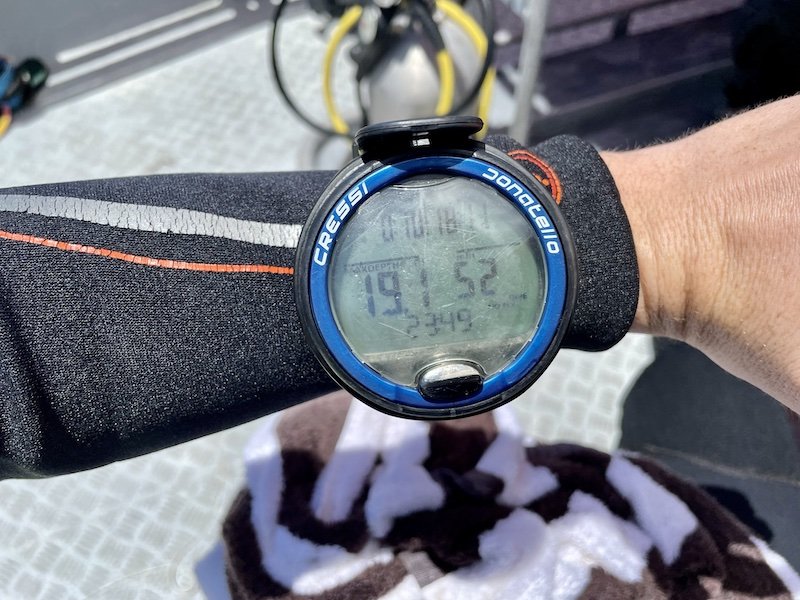
Generally, no, you can always rent whatever dive gear you need.
I’ve sorted this diving packing list into ‘need-to-haves’ and ‘nice-to-haves’ because I do believe it is really important to own your own core gear, if it’s within your means.
However, I also acknowledge that going diving quickly gets very expensive, and dive equipment is not cheap… plus, it takes up a lot of space.
I recognize not everyone has the funds or the storage facilities for full-on dive gear (I make it work in my tiny 500-square-foot apartment, but I also have tons of closet space).
That said, there’s something to be said about having your own dive gear that you know and trust.
Don’t worry — you can still dive even if you don’t have a single piece of gear! I’ll tell you what I think are the most essential, though.
I’ve slowly been building up my dive equipment kit over the past year and I’m grateful that I now have a self-sufficient enough dive kit and that all I would need to do is rent tanks and a weight belt!

However, I still tend to dive with dive operators as my dive experience is only intermediate, with a little over 30 dives under my belt.
Plus, I prefer the expert knowledge that comes with dive shops, because their dive masters can bring us to the best dive locations and know the conditions of each dive.
For me, the benefit of having my own gear is knowing it and trusting it so I can dive comfortably.
I know my own equipment is in good condition and is up-to-date on its servicing. Plus, I’m familiar with all the ins and outs of it, and don’t have to have a learning curve on each dive.
While a good dive operator will have well-serviced equipment, things are more in your own hands when you have your own gear.
What to Pack Dive Gear In
Depending on how you decide to pack for your dive trip this truly depends!
If you are bringing a lot of your own pieces of equipment, you will want a specialty suitcase designed with diving gear in mind.
I recommend the Cressi roller bag / backpack combo , which can easily fit a full scuba kit (and then some!).
It has lots of thoughtful touches like a side pocket for fins, water-resistant construction,
In addition to your checked bag with your gear, your carry-on luggage should carry anything sensitive or valuable (regulators should go in your carry-on!), as well as any personal items you want in flight.
I also suggest bringing a few items of clothing in your carry-on just in case your luggage gets delayed!
What to Wear on a Dive Boat
Bathing suit.

It’s useful to have a bathing suit layer underneath your wetsuit for a few reasons.
For one, it makes peeling off your wetsuit layer to warm up during a surface interval a lot easier.
I also prefer wearing a bathing suit to full garments like a rash guard, etc. because I find it easier to get a little sun on me to dry off and warm up.
That said, there are countless things you can wear under a wetsuit !
Getting your core dry and warm is the easiest way to warm up after a dive.
I get a lot less cold wearing a bikini than a one piece, since there’s less material on me that’s wet.
My bikini is no longer sold online, but here are a few I like: this black and white printed two-piece , this colorful high-waisted set , and this fun sporty colorblock two-piece set .
Flip Flops
For the most part, you won’t actually wear your shoes on the boat — many boats ask you to take off your shoes when you board.
Make it easy on yourself with some simple flipflops like Havaianas .
Sun Hat
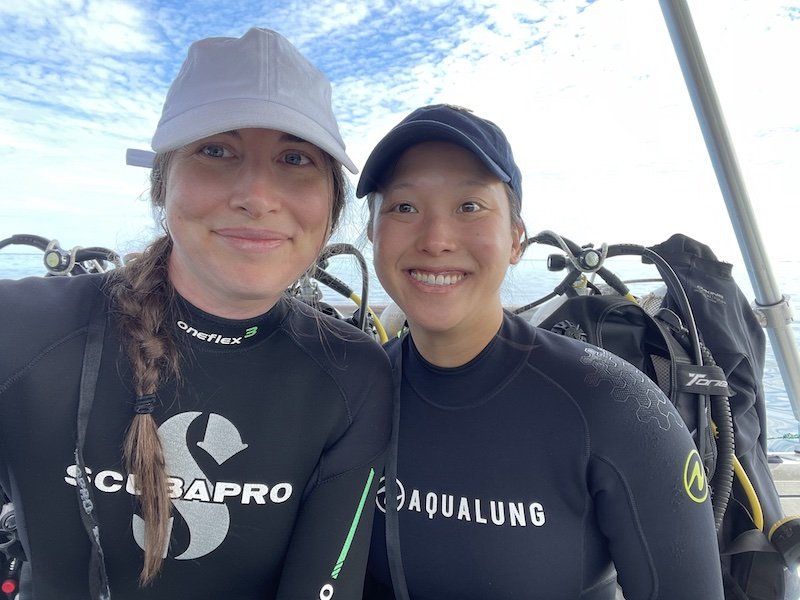
Between getting to and from your dive site and being exposed to the sun during your surface interval, you’ll need some sun protection.
I prefer an adjustable baseball hat that won’t fly off even if your captain is driving the speedboat like a madman to get to the dive site!
Layers / Sun Protection
Besides keeping the sun out of your face, you’ll also want layers like a dive shirt or rash guard to keep you protected from the sun while you’re on the boat.
For the first dive, you can just wear a normal T-shirt, and to relax between surface intervals, you should bring something like a long-sleeve rashguard or dive shirt.
I like this colorful and fun dive shirt !
Cheap Sunglasses
You don’t want to bring your nice sunglasses on a dive boat, trust me!
It’s easy for them to get lost, especially when you’re packing up at the end of a long day of diving.
Bring a cheap pair of sunglasses specifically for the dive boat — I like these ones which are cute but inexpensive .
Hair Protection
If you have long hair, you’ll want to keep your hair protected. Salt water and mask straps can really do a number on your hair.
The easiest way to protect your hair is with a simple fabric headban d which will keep strands of hair from getting in your mask (which hurts the seal as well as breaking your hair).
Another way to protect your hair is with a neoprene mask strap which will keep you from breaking the hair on the back of your head.
And if your hair does end up getting rather gnarly after dives anyway, the Sea 2 Stream leave-in conditioner works miracles (truly, miracles — my thin, easily broken hair can attest to that).
Need-to-Have Dive Gear
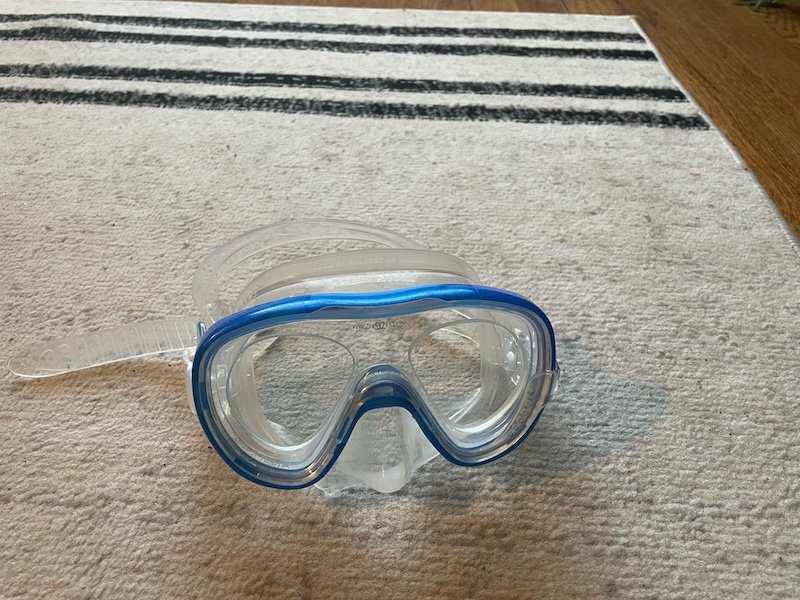
Anyone who goes scuba diving should have their own mask, point blank. If you buy one item — make it this.
Your mask is one of the most essential items for diving: after all, your sight is one of the most important things that keeps you safe underwater.
Having a reliable mask you know and love means no struggling with mask flooding, fogging, etc. and other stressful situations that can negatively impact a dive.
I use this TUSA mask and am extremely happy with it!
Keep in mind that your mask should fit well, and many masks can be too big depending on your face shape.
As a rough guide, you’ll want to fit about two fingers between your hairline and where the mask hits.
You’ll also want a snorkel for use on the surface to conserve your air (especially if you’re doing shore dives).
A snorkel is also a safety device: it’s a back-up breathing device in case you get tired during your dive and don’t have any more air in your tank when you surface.
I use a TUSA Hyperdry Snorkel which has a dry top chamber that covers the opening of your snorkel to reduce the amount of water that can get into your snorkel.
It also has an angled purge chamber for easier purging — I find I have to use less intense exhales to satisfactorily purge my snorkel.
Fins & Dive Boots (If Needed)
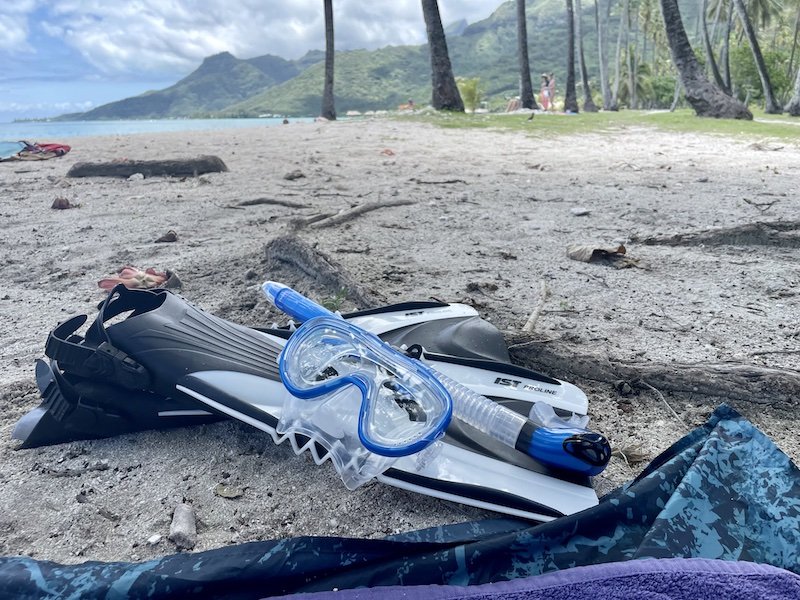
I have simple IST Proline fins that are no longer available online — they’re actually more designed for snorkeling than scuba diving, but I’ve enjoyed how lightweight they are.
I am planning to upgrade to a better set of fins in the future, such as these Tusa open-back fins combined with a 3mm neoprene bootie ( like this one from Cressi ) to keep my feet warmer.
I prefer open-back fins because they’re way easier to remove when you’re getting back on the boat, which is helpful because normally you’re quite tired at this point and don’t want any more struggle than you need
Split fins are another popular choice but I haven’t tried it yet!
Surface Marker Buoy (SMB) / Safety Sausage
It’s really important to have your own safety sausage / SMB attached to your BCD.
While it’s unlikely that you’d get separated from your divemaster if you’re being vigilant, having one can make your safe rescue a lot quicker.
If you’re diving with a DM, you likely don’t need one of the SMBs that inflate underwater, with words on it indicating that there are divers below.
I bought mine at my local dive shop here, but you can find a similar one here . It’s easy to inflate with just a few breaths at the surface.
If you’re shore diving with a buddy and think there’s a chance of boat traffic overhead, you’d want a DSMB.
Dive Computer

Okay, so a dive computer is absolutely an investment, but I do think it’s really important to have your own dive computer or dive watch.
It can be overwhelming to decide what dive computer to get if you’re a beginner, so I’ve demystified it in this (simplified) guide to the best entry-level dive computers .
For one, most dive computers have an app so that you can download all your dive profiles and easily log your dives.
This can come in handy later down the line, when PADI certifications or more advanced dive trips or dive sites require a certain number of logged dives.
Plus, being familiar with your dive computer is a safety matter.
You’ll want to know how it alerts you about rapid ascents, how it displays depth, how it alerts you about approaching your no decompression limit (NDL), and how it monitors safety stops.
I use a Shearwater Peregrine which I admit is a bit of a splurge (I wanted a backlit display for easy visibility especially on night dives).
My girlfriend uses this Aqualung i300 dive computer and is happy with it overall, and it’s a good $200 cheaper.
Dive Certification Cards
Don’t forget to bring your PADI or other certification card to your next dive trip!
Generally, a dive shop can look you up in the PADI database and find your certification, but it would be awful to not be able to dive in case they can’t find you for some reason.
Dive Insurance
I saved the last for the most important — dive insurance. Yes, not technically ‘gear’, but absolutely a need-to-have.
Many travel insurances don’t fully cover scuba diving accidents, and so you’ll want to read the fine print and ensure you’re covered in case of a diving accident.
The biggest thing to worry about is decompression illness (DCI or ‘the bends’), which requires treatment in a hyperbaric chamber… a treatment which can cost several thousand dollars.
DAN provides an annual dive insurance plan, which I buy and then I pair that with a travel medical insurance like Safetywing to ensure I’m covered in case of other illness, accidents, or trip interruptions.
Nice-to-Have Scuba Gear
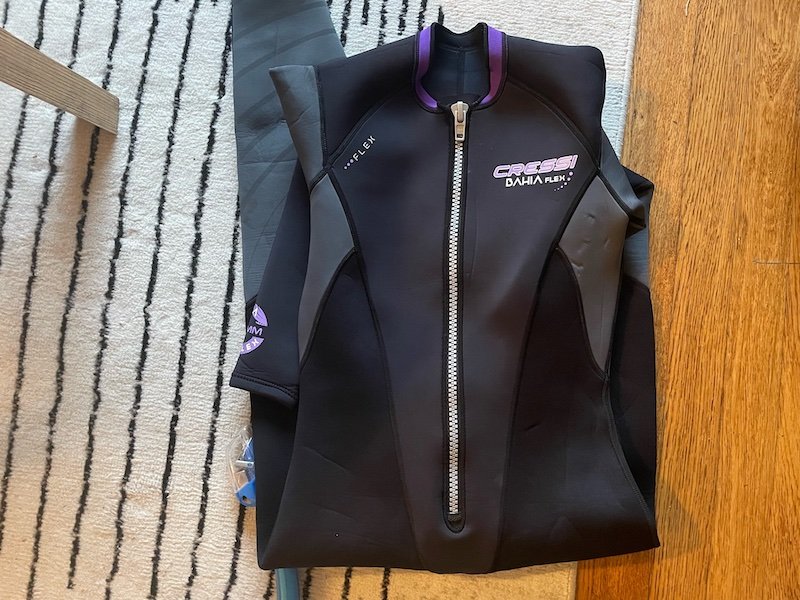
One of my biggest pieces of diving advice is to know what the water temperature is where you’re going and how you tend to feel in the water.
I can tell you from recent experience, it’s really unpleasant to arrive at your destination excited to dive… and emerge from your first dive chilled and worrying about how the rest of your trip is going to go.
I took my 2.5 mm Cressi wetsuit to Cozumel, where the water temperatures were consistently 79°/80° F (around 27° C).
Despite being more than comfortable in a 3mm on my dives in Tahiti and Moorea in water that was more like 77°-78°, I was pretty chilled in my 2.5mm.
That’s because Cozumel has a lot of drift diving where you don’t really build up your body temperature, because you’re still and just allowing the current to take you.
I ended up having to rent a 5mm for the rest of my dives, making my wetsuit pretty much moot to bring!
You can bring a 3mm dive vest to offset any chill you might be worried about — I’m planning that for my next trip.
I’ve also gone ahead and bought this Cressi 5mm wetsuit too and just got back from wearing it while diving in Roatan where it was perfect.
I’ve reviewed some other 5mm wetsuits in case you also run cold!
Generally, I love Cressi wetsuits for being high-quality yet affordable: a fraction of the price of brands like Aqualung and Scubapro but still really good!
If you know you’ll be diving in cooler or cold water, you’ll probably also want to bring a 7mm wetsuit and a dive hood like this one.

I recently got my own BCD — it’s an older version of the ever-popular Scubapro BCDs that I got when a local dive shop closed for business.
That exact BCD is no longer available online (frankly, the colors make it look like it came from the 90s, but it works fantastically) — and the Scubapro BCDs I can find are all $500+.
If you’re looking for an entry level BCD, I’d suggest something like this Cressi BCD or a pricier Aqualung BCD .
Regulator & Spare O-Rings
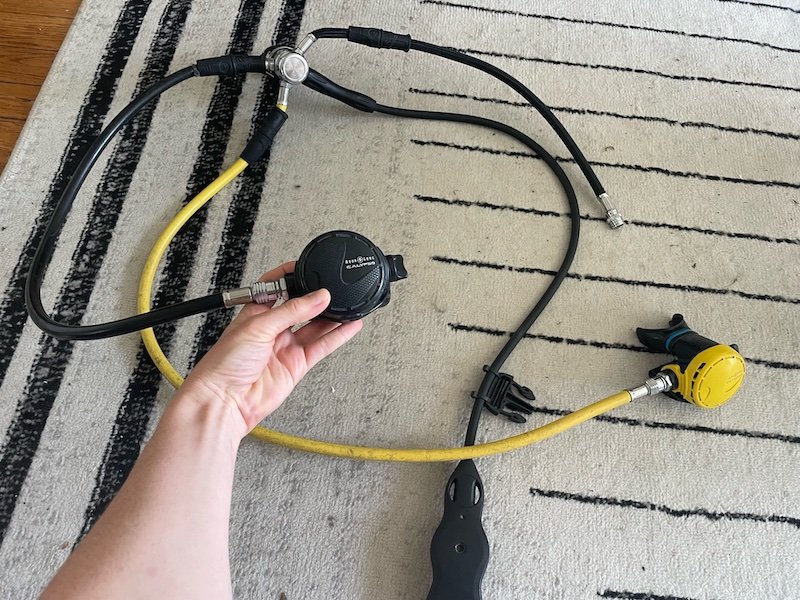
I’m now the proud owner of my own regulator!
When I dove with ScubaTony in Cozumel, they had a great deal where you could buy used Aqualung regulators and buy back the rental fee you paid.
To have the same set up I have, you’d want a Aqualung Calypso regulator (comes with hose), Aqualung Calypso octopus , and a pressure gauge like this one (pick PSI or bar, whatever you’re most comfortable with — I use PSI).
Aqualung is practically synonymous with regulators and is the gold standard of most dive shops.
Since your regulator is literally your lifeline, it was a place where I wasn’t planning to skimp on spending.
You should also bring some spare O-Rings just in case one pops out (this happened to me once on a recent dive trip!)
Generally not really necessary, some people like to have a dive knife handy in case you encounter fishing line or nets, or to help any marine life that may be in trouble for the same reason.
Dive knifes are more necessary if you dive in places with kelp forests like Monterey or in wrecks.
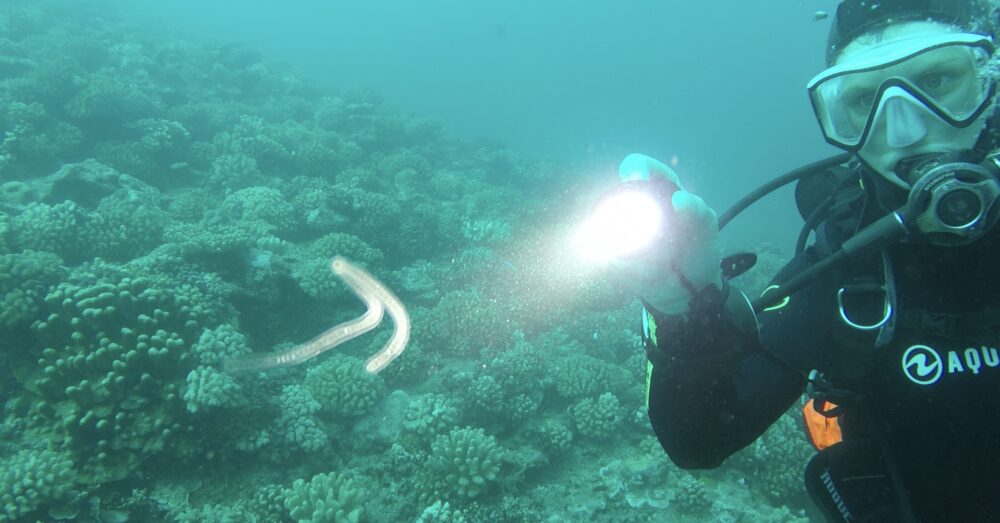
Whether you’re planning night dives or just like to peek into crevices to try to spot shy sea creatures like lobster, shrimp, and eels, a dive light or dive torch comes in handy!
If you’re night diving, keep in mind you’ll want both a primary light and a backup light.
You can get a cheaper dive light like this one or splurge on a higher-quality one .
If you like a pen-and-paper logbook , they can be a fun way to keep track of your dives and write down any notes about problems you had or what you saw on a dive.
Those dive memories can go quick so it’s always nice to write things down in a log book (or in your phone) during a surface interval.
Frankly, if you use a modern dive computer that imports your dive data, this isn’t really necessary anymore, but some people like the analog vibe of log books.
Reef Hook (If Allowed/Needed)
On certain drift dives you may need a reef hook , which you attach to a rock (rather than living coral) to keep you in place with minimal damage to the reef.
They’re not allowed in many places or necessary in others, so check on the dives you are planning to do to see if it’s necessary.
Camera Equipment for Diving
Underwater camera like gopro and underwater housing .
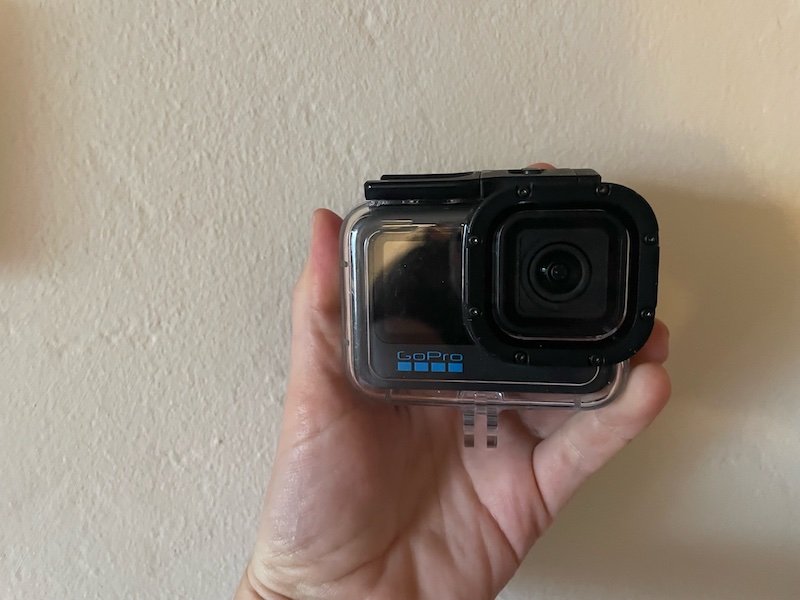
Taking great videos of your dives is the best way to remember your diving trip! I recently upgraded my GoPro set-up and I see miles of difference.
I use a GoPro Hero 11 with the proprietary GoPro dive housing (I’m not taking any chances on a third party dive housing when my GoPro costs several hundred bucks!)
You’ll also need either a floating stick or a dive tray. The latter keeps your footage more stable, but it can be rather unwieldy.
My girlfriend uses this Movo dive tray (with mounted dive lights ) and gets really great footage, but she’s dialed in her buoyancy control quite well.
If you’re just starting off diving or capturing underwater photography, you’ll probably just want a floatie stick so that you can focus on other aspects of your diving.
You’ll also want a lanyard for your floatie/dive tray to make sure it’s secure on your BCD.
Memory Cards
You’ll need a micro SD to go with your GoPro. I suggest getting one with a decent amount of memory, because the new GoPros have 4K which take up a lot of space.
I suggest having an extra one in case yours corrupts or you fill it with too many scuba memories and you don’t want to have to delete footage before you’re ready to.
Filters for GoPro
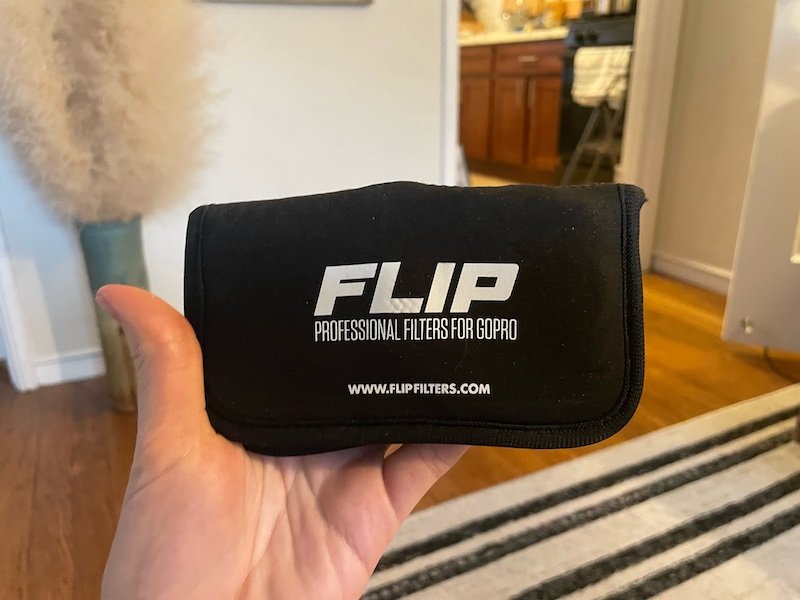
The best addition to a GoPro is dive filters — I invested in these Backscatter flip filters and they are amazing!
You never have to worry about your footage getting locked into one (bad) filter — you can adjust the filters extremely easily while underwater by just flipping the filters on or off.
I bought the dual system, which has filters for both 20-40 feet depth and 40-80 foot depth.
It’s a little pricy, but for how it amazing it makes my footage — it’s absolutely worth it.
Extra Batteries
Having extra GoPro batteries is always nice, especially if you’re doing repetitive dives.
Having these GoPro batteries which come with a separate charging port so you don’t have to have your GoPro plugged into the wall to charge is really helpful, too.
Stuff for Surface Intervals
Quick dry microfiber towel.
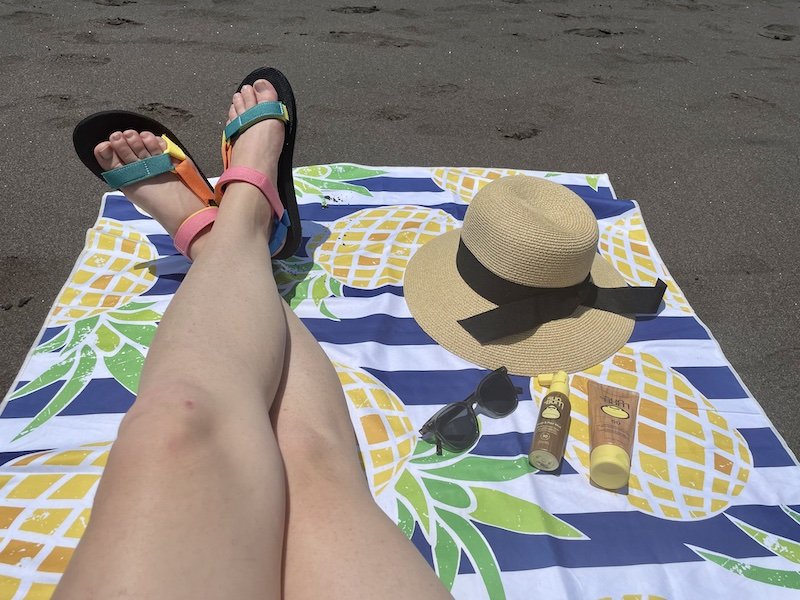
The best way to warm up after a dive is to dry off. Yes, it may feel awful when you first peel off that wetsuit but you’ll be grateful for it in less than a minute!
I always bring a small microfiber towel — and next trip, I’m thinking of bringing two small ones because then each one will be dry on a two-tank dive.
Sun Protection Clothing
As mentioned above, you’ll want to bring something dry to cover up in during your surface interval / return trip after your second dive.
That can be a rash guard, a dive shirt, a swim cover up, or even just a plain T-shirt — as long as it protects you from the sun, it’s good to have!
Additional Clothing
If you want to change out of your swimsuit into fresh clothing when you get back from your dives, it’s nice to have a change of clothing in your bag.
Just make sure it stays dry!
If you’re staying at a nice resort like the Atlantis Bahamas , Kanuhura Maldives , etc., you’ll likely want some nicer clothes you can change into before you arrive at the resort.
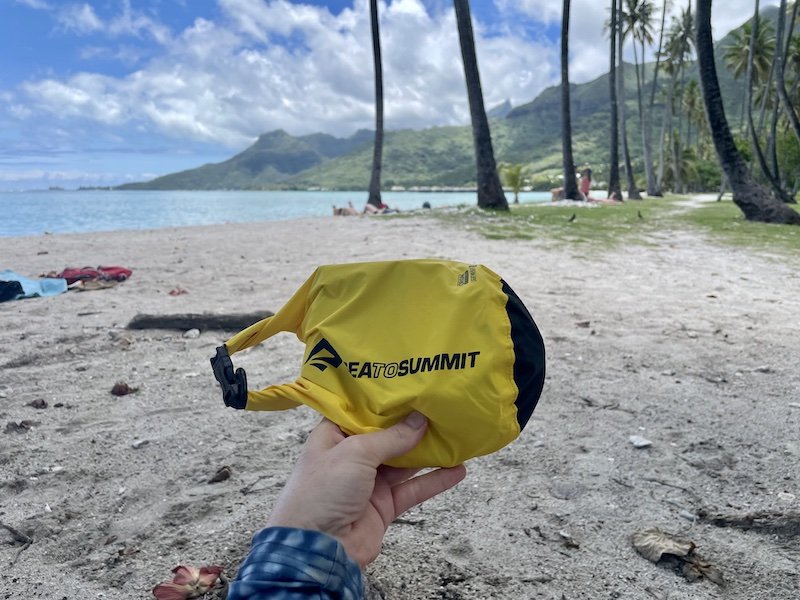
… and a dry bag will help with that! It’s handy for keeping things like your change of clothes, your wallet/money, your phone, etc. all stay safe from salt water.
Get a small one if you only want to keep your basics dry or get a larger one if you also want to keep clothes dry.
Sea to Summit is the most-trusted dry bag brand, so it’s what I’d go with.
Other Dive Travel Musts
Reef-safe sunscreen.

It’s extremely important to use reef-safe sunscreen when you’re diving if you want the reefs to still be there in the future!
I love Sea 2 Stream for reef-safe sunscreen — they have a regular version and a tinted version in case the white zinc is not your favorite look.
The worst two sunscreen ingredient offenders are Oxybenzone and Octinoxate — avoid those at all costs!
Other ingredients to avoid are Benzophenone-1, Benzophenone-8, OD-PABA, 4-Methylbenzylidene camphor, 3-Benzylidene camphor, and Octocrylene.
Check the ingredients yourself because there is no regulation for what a company calls ‘reef-safe’, and unfortunately some brands that advertise themselves as reef safe are actually not.
You’ll want to use a lip balm to soothe chapped lips, which can get exacerbated by salt water and the sun.
Make sure you don’t use anything with SPF because that goes against the whole point of reef-safe sunscreen! I like Aquaphor .
Motion Sickness Pills (Dramamine)

If I’m on a surface interval that is just out at sea, it’s quite easy for me to get seasick.
I take less drowsy Dramamine one hour before I plan to leave for my first dive, and it keeps me feeling well for a two-tank dive, including the surface interval.
You can also take all-natural ginger Dramamine 30 minutes before your first dive. It’s not quite as effective, but if you are less prone to seasickness, it may be enough!
Ear Drops
If you have any problems with equalizing or swimmers ear, divers swear by Diver Drops .
It’s not something I’ve needed to use yet, luckily, but if you are prone to ear problems you may want to give it a try.
Mask Defogger
Yup, you can do the ol’ spit and rinse, but having mask defogger at hand is always nice.
I always feel more comfortable having used it and knowing I’m going to enjoy my dive… nothing is worse than a foggy view while you’re trying to enjoy your dive!
Allergy / Sinus Medication
If you are prone to getting stuffy, I suggest bringing whatever allergy medicine you typically take at home. I take Zyrtec and I also use Flonase .
Note that you should be cautious with using decongestants like Sudafed, etc. as this can potentially cause problems.
DAN recommends exercising caution with it (and better off avoiding it entirely), and never using it to dive despite being sick.
General Travel Essentials
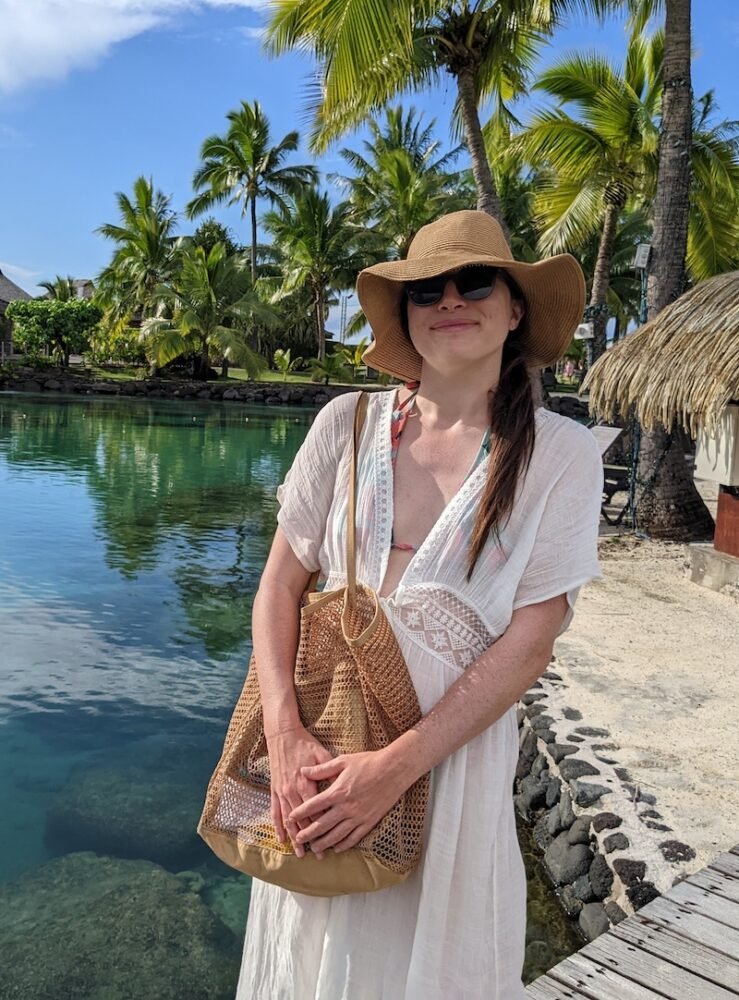
- Clothing for Your Trip (for an example of a tropical packing list, check this Tahiti packing list )
- Noise-Canceling Headphones
- Insect Repellent (be sure to shower this off if you use any chemical based ones before you dive!)
- Credit Cards & Debit Cards
- Mobile Phone & Charger
- Laptop & Charger, if bringing
- Travel Adapter, if needed
- Camera Gear
- External Battery Pack
- Mini First Aid Kit
- Medicine (Birth Control, Prescription Medication, etc.)
- Your Own Water Bottle
Similar Posts

Scuba Fins vs. Snorkeling Fins: What to Look For & My Top Picks for Each
There’s a lot to demystify when it comes to picking out the right beginner scuba gear and, to a lesser extent, the right beginner snorkeling gear. One thing that trips most people up (no pun intended!) is whether they really need scuba fins vs. snorkeling fins — what even is the difference, anyway? I’ve used snorkeling…

What to Wear Snorkeling: Complete Guide for Beginners & Beyond
If you’re not sure what to wear when snorkeling on your upcoming beach trip trip, don’t worry — I’m here to demystify all that for you, as an avid diver and snorkeler. For many years before I got scuba certified, I was a dedicated snorkeler, having learned when I was just a kid because I…
Leave a Reply Cancel reply
Your email address will not be published. Required fields are marked *
Save my name, email, and website in this browser for the next time I comment.
- Best Sellers
- New Arrivals
- Versatile Jewelry
- By Collection
- Fundraisers
- Custom Order
- PADI Partnership
- Earn Points
- Brand Ambassador
- Store Locator
- Meet the Makers
- Stack & Save
Sign up and save
Entice customers to sign up for your mailing list with discounts or exclusive offers. Include an image for extra impact.
The Ultimate Packing List for Your Next Dive Trip: From Sustainable Scuba Jewelry to Essential Technical Gear

Since the beginning, Tula Blue has always championed celebrating and elevating communities for a greater purpose. Each individual piece of jewelry is hand-spun by local artisans who instill hope, health, happiness and harmony into every single design. But most importantly, they are knotted together to tie kindred spirits together to make the world a better place.
That is why Tula Blue has partnered with PADI, which has the world’s largest community of ocean lovers. As part of this, PADI Club members will receive special benefits that include 15% off of their purchases, as well as 5% of proceeds automatically being donated to PADI AWARE .
Weaving these two community-driven organizations together means that the global scuba diving collective will not only grow but feel even more empowered to keep our shared blue planet beautiful and healthy.
So whether you are still considering becoming a certified PADI Scuba Diver or are plotting out your next diving adventure, we have created the ultimate guide for everything you will need for your scuba kit. From the best scuba jewelry to technical diving gear, here are the must-haves when it comes to packing your bag before descending into the depths of the ocean.
Must-Have Scuba Items to Pack
1. scuba jewelry that helps you save the seas.
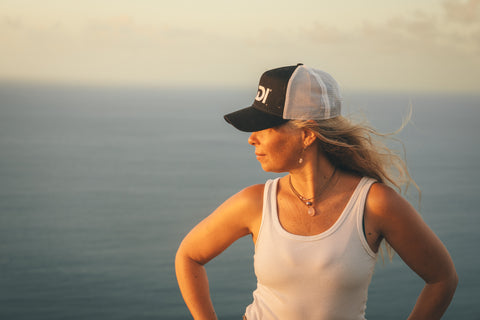
Scuba jewelry comes in all shapes and sizes – from crystal pendants to pearl earrings.
Have you ever wondered if you should wear jewelry on your next scuba diving holiday? While you may have heard mixed reviews, there are actually a range of quality scuba jewelry that is sustainable, designed to dive in and gives back to helping protect the ocean.
I f you want to wear jewelry while scuba diving, we suggest ensuring that the base is made from nautical grade rope . Using the same materials that sail boats use, this rope is designed to be waterproof, durable and weather all types of ocean environments. It also means that it can withstand the rubbing and tugging from your wetsuit and gear.
From necklaces to anklets, there are a variety of scuba diving jewelry that you should consider packing. Plus, doing so is one of the biggest TSA hacks – as you can also wear these during transit and not get pulled aside for a full pat down from an agent.
Here are the waterproof jewelry that pack well, can be versatile enough to wear during your surface intervals, are sweat proof and beautify scuba diving and the ocean.
Sea Glass Bracelets: bring along these limited edition handmade sea glass bracelets that are 100% waterproof and designed to help remind us all to keep the ocean clean. 10% of each purchase for these limited edition bracelets will be donated to PADI AWARE to support the community of scuba divers who are passionate about taking local action for global impact.
Pendant Necklaces: keep a drop of the ocean close to your heart at all times with a stone pendant necklace. A staple to every scuba diver’s wardrobe, a pendant necklace will help you channel the metaphysical properties to be a superhero for the ocean and feel connected to the natural underwater world.
A Trifecta of Pearls: every scuba diver should rock the collection of waterproof pearl jewelry for their next adventure. Created from life within the ocean and also one of the ocean’s most valuable treasures, wearing a pearl necklace, bracelet or anklet while scuba diving is symbolic of your loyalty to preserving the ocean’s beauty.
A Multi-Use Necklace: this multi-use piece of jewelry is perfect when wanting to pack with a purpose. Adjustable to fit numerous styles, you can rock this with a rashguard or bikini, wrap it around the wrist as a bracelet or even around your sun hat as an added accessory. Plus, it stacks great with other pieces of scuba jewelry too.
2. Technical Dive Gear That is Stylish and Functional

Scuba jewelry helps accessorize your technical diving gear.
While you can almost always rent your entire technical dive kit from any dive center around the world, it is always worthwhile to consider investing in and bringing your own diving gear.
Just like every piece of scuba jewelry is unique, so is each piece of dive gear. One style of gear may fit you better or worse than someone else – so why risk having to use gear that’s not the perfect fit for you?
Bringing your own diving gear will give you peace of mind that you will be comfortable diving, your gear is in great condition and you know how to use it. While you don’t always need to bring a complete kit if you are sparse on space, these core pieces of gear should always be packed for your underwater adventure.
Regulator: this is your literal source of air and life support during scuba diving. Bringing your own regulator means that you don’t have to adjust settings and have comfort in knowing you are the only person to ever breathe into it. They are compact and not too heavy, making it easy to bring along without going over weight limits at the airport.
Dive Computer: there are so many varieties of dive computers and is another essential piece to a dive kit. Not all dive centers rent smart dive computers, so having your own means you not only can read your depth, and bottom time and monitor safety stops but many brands also log the dives automatically for you. You can also style your dive computer with scuba jewelry like pearl bracelets to make the style unique to you.
Mask + Snorkel: because each person’s face is different, not all masks fit equally. Packing your scuba mask means that you know it is fit for you personally and lowers the chances of it fogging up. Plus it means that you can easily snorkel or freedive spontaneously when you’re not scuba diving too.
BCD: while this is the bulkiest of the technical dive gear, it is equally one that you want to have confidence in. Bringing your own quality and recently serviced BCD will mean that you can rest easy when it comes to staying buoyant both above and beneath the surface. Plus, with all your compact travel scuba jewelry, there will be plenty of extra space for this in your bag.
3. Reusable Water Bottle That Keeps You Hydrated and Plastic-Free
In addition to packing sustainable scuba jewelry on your next adventure, you also want to pack a reusable water bottle to cut down on your plastic consumption overseas.
Even though you will be adventuring in the water, you will want to make sure you stay hydrated throughout your trip. Bringing your own reusable water bottle means you can cut down on needing to buy plastic bottles and also encourage your fellow dive buddies to do the same.
Keeping hydrated on a scuba diving adventure is key to ensuring you feel beautiful and have the energy you need to enjoy every single second of it.
4. Exposure Protection That is Reef Safe and Functional
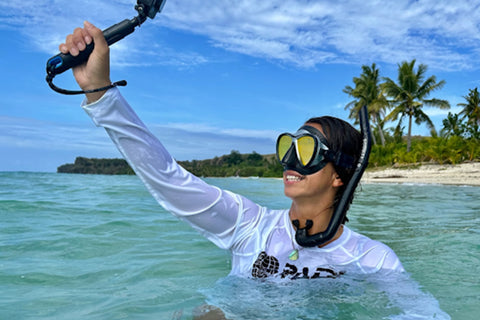
Scuba jewelry is multi-functional and can be worn with an exposure rashguard or even a sun hat.
Even on a cloudy day out at sea you will want to make sure you have put plenty of sunscreen on. But you will want to make sure that it is also reef safe sunscreen, because the last thing you want to do is damage the beautiful places you are exploring.
Make sure to pack reef safe sunscreen in addition to other exposure protection like a good sun hat or rash guard. The great news is you can style both of these additional measures up with waterproof jewelry. You can turn your pearl necklace into a hat band during your surface interval or wear it over your rash guard.
5. Underwater Camera That Captures Yours and The Ocean’s Beauty
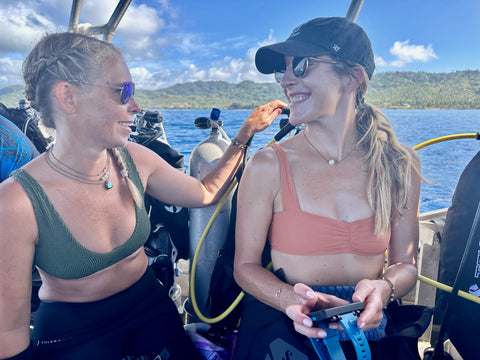
Scuba jewelry is designed for you and your dive buddy to feel like your most beautiful selves.
One of the best ways to inspire others in your community to join you on your underwater adventures is to capture your experience on camera. So don’t forget to pack your underwater camera to capture those epic moments in the water.
There are a range of different waterproof cameras that take high-quality footage – along with some cases that allow you to even bring your phone underwater. But make sure that whatever you do pack, it comes with a waterproof housing designed to go to big depths underwater – this is one of the main things many scuba divers forget to pack.
Of course, if you are just learning how to scuba dive, ask a more experienced dive buddy or your guide to take photos for you until you feel confident in your scuba skills.
6. Dry Bags With Optimal Storage Capabilities
Things are likely going to get a bit wet out at sea, so don’t forget to pack a dry bag in your suitcase. The best dry bags are designed to not only be easy to carry but have enough volume to help you bring all the scuba essentials onboard – from your phone and keys to snacks and towel.
And while designed to be waterproof, it is also a great place to store your extra scuba jewelry in case you want to change your look before descending underwater.
7. Leave In Conditioner for Salty Hair
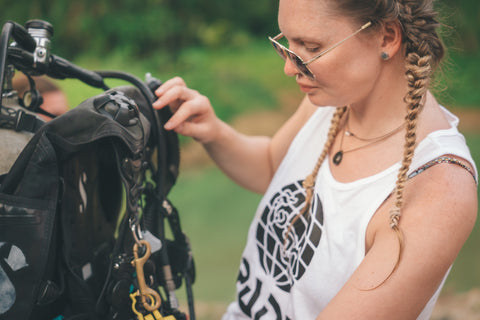
Scuba jewelry is designed to withstand the salt and depths of the ocean.
Things can always get a bit messy during an adventure in the ocean – especially your hair. The salt, waves and scuba gear are likely to leave your hair feeling a bit tangled, especially if you are doing multiple dives per day.
While wearing your hair in braids can help minimize the mess, rubbing reef-safe leave-in conditioner onto your hair after your time in the water helps detangle any knots and easily get the braids out. By the time you are back on land from your dive your hair will be feeling silk, healthy and ready for the next adventure.
Just make sure that the leave-in conditioner you get is reef-safe too, especially if you plan on going back in the water after applying it.
8. Dive Log Book to Capture the Memories

The best scuba adventures are accessorized with durable and waterproof scuba jewelry.
Adventures of any depth are always worth remembering. Which is why you don’t want to forget to pack your diving log book.
Diving log books hold some of your greatest memories, allowing you to not only record the general diving stats from your adventure but also write notes about anything memorable you experienced. There is also space for the dive center to leave its unique stamp and have your instructor, guide or dive buddy sign your book.
Final Packing Tips: Multi-Use Hacks

Scuba jewelry is also sweat proof jewelry for your surface interval adventures.
Taking the time to pre-plan your packing checklist will help you have a beautiful and bold adventure. Always pack for quality and multi-use over quality.
For example, bringing scuba jewelry that can double as other adventure jewelry means that it will also be sweatproof for your on-land excursions when you aren’t scuba diving. It also means that you can wear the crystal pendant that brings you the most comfort on your flight as it is TSA-approved jewelry.
And a final pro tip with the scuba jewelry – don’t hesitate to leave behind some of your scuba jewelry to others that you meet along the way. It will help keep your similar wanderlust spirits connected and serve as a reminder that we all share a similar passion and admiration for the ocean we love to explore.
Where will you be going scuba diving next and what scuba jewelry will you be rocking underwater?
Leave a comment
Please note, comments must be approved before they are published
This site is protected by reCAPTCHA and the Google Privacy Policy and Terms of Service apply.
- Hiking Shoes
- Hiking Boots
- Hiking Sandals
- Trail Runners
- Base layers
- Hiking Shirts
- Fleece Jackets
- Softshell Jackets
- Rain jackets
- Down Jackets
- Hiking Pants
- Hiking Shorts
- Base Layers
- Rain Jackets
- Hiking Bras
- Baby Carriers
- Cookware Sets
- Water Filters
- Water Purifiers
- Sleeping Bags
- Sleeping Pads
- Hiking Poles
- GPS Devices
- Solar Chargers
- Dive Regulators
Dive Computers
Dive Watches
- Dive Wetsuits
- Dive Gloves
- Dive Lights
- Dive Knives
- Spearfishing Wetsuits
- Spearfishing Masks
- Spearfishing Fins
- Spearfishing Watches
- Freediving Wetsuits
- Freediving Masks
- Freediving Fins
- Freediving Watches
- Sit On Top Kayaks
- Inflatable Kayaks
- Fishing Kayaks
- Tandem Kayaks
- Touring Kayaks
- Kayak Paddles
- Kayak Seats
- Kayak Roof Racks
- Kayak Carts
- Stand Up Paddle Boards
- Touring SUPs
- Inflatable SUPs
- Fishing SUPs
- SUPs For Yoga
- SUPs For Surfing
- SUP Paddles
- Climbing Boots
- Belay Devices
- Climbing Shoes
- Women's Climbing Shoes
- Bouldering Shoes
- Approach Shoes
- Climbing Pants
- Bouldering Pants
- Mountain Bikes for Men
- Mountain Bikes for Women
- MTB Handlebars
- Bike Saddles
- Bike Computers
- Bike Lights
- MTB Jackets
- Bike Helmets
- Bike Packing Gear
- Fat Biking Gear
- Ski Bindings
- Ski Helmets
- Ski Goggles
- Ski Jackets
- Snowboarding Bindings
- Snowboarding Boots
- Snowboard Helmets
- Snowboard Goggles
- Snowboard Pants
- Snowboard Jackets
- Snowshoe Poles
- Avalanche Beacons
- Avalanche Probes
- Avalanche Shovels
- Ski Backpacks
- Surfboards For Beginners
- Surfboards For Kids
- Surfboard For Small Waves
- Soft Top Surfboards
- Foam Surfboards
- Body Boards
- Boogie Boards
- Kiteboarding Kites
- Kitesurfing Boards
- Kiteboarding Harnesses
- Surfing Wetsuits
- Men's Rash Guards
- Women's Rash Guards
- Board Leashes
- DLSR Travel Cameras
- Mirrorles Travel Cameras
- Point and Shoot Travel Cameras
- Fuji Travel Lenses
- Nikon Travel Lenses
- Tripods for Travel
- DLSR Landscape Cameras
- Mirrorles Landscape Cameras
- Point and Shoot Landscape Cameras
- Fuji Landscape Lenses
- Nikon Landcape Lenses
- Canon Landcape Lenses
- Tripods for Landscape Photo
- Wildlife Cameras
- Wildlife Lenses
- Wildlife Tripods
- Wildlife Monopods
- Birdlife Cameras
- Birdlife Lenses
- Surfboards For Small Waves
Packing List For Dive Travel
You probably already know there are many reasons to be a scuba diver . You travel, meet new people, see marine life… But you also need quite a bit of gear and when you travel you don’t want to forget anything back home.
Are you planning to go on a dive vacation or liveaboard trip and not sure what to bring? No worries. Here’s our packing list to make sure that you don’t leave anything behind!
SCUBA EQUIPMENT
Now that airlines have drastically reduced passenger’s baggage allowance, the weight and size of your diving equipment are important factors to consider. Experienced divers know the value of diving with their your own gear, you know it works and it’s more comfortable. If you plan to go on diving trips often, an investment in quality travel equipment is worth while. Here’s our list of what equipment to pack, along with a few recommendations of lightweight gear.
We use and recommend Cressi’s Travelight , it’s light but still has all the features of a traditional BCD. Other great options are the Aqualung Zuma and the ScubaPro X-One . All of these options fold down small, saving you lots of room.
Best Scuba BCDs of the Year >>
LIGHTWEIGHT REGULATOR AND OCTI
Best Diving Regulators of the Year >>
PRESSURE AND DEPTH GAUGES
Best Scuba Gauges of the Year >>
Best Diving Fins of the Year >>
Best Dive Boots of the Year >>
MASK & SNORKEL
Best Diving Masks of the Year >>
Best Dry Snorkels of the Year >>
DIVE COMPUTER
Best Dive Computers of the Year >>
Best Air-Integrated Dive Computers of the Year >>
Best Diving Gloves of the Year >>
Best Diving Wetsuits of the Year >>
SURFACE SIGNALING DEVICES
Best Diving SBMs of the Year >>
Best Dive Lights of the Year >>
When going on a dive vacation you don’t need nearly as many clothes as you would on a normal vacation because most of the time you are going to be under water or relaxing (in your swim gear) before the next dive.
- Quick Dry T -shirt or tanks
- Quick Dry Shorts
- Light windbreaker or rain jacket
- Long pants
- Travel Towel
- Sturdy walking sandals
PHOTOGRAPHERS LIST
If you enjoy taking pictures underwater make sure to bring all of your chargers. Nothing ruins your plans more than a camera with a flat battery.
- Camera Housing
- Extra SD Cards
- Extra Battery Cables
- O Ring Grease
- Moisture Munchers
Here’s some extras that you shouldn’t forget. Remember sunblock and a hat to protect yourself from the sun during side trips and times lounging around the dive boat. Putting a wetsuit on over sun burnt skin isn’t fun! Dive boats can be noisy, especially if you get a cabin near the engine room. If you’re a light sleeper, it’s good to bring a set of earplugs.
- Motion Sickness Tablets
- Contacts, Solution and Case
- Sunglasses
- Rubbing Alcohol
DOCUMENTS AND PAPERWORK
Be sure to pack all of your C cards. Some dive locations are in remote areas where internet is scarce, don’t rely on the dive center being able to look you up in the system.
- Flight Tickets / E-ticket Confirmation
- Certification Cards
- Nitrox Card
- Dive Insurance Card
ELECTRONICS & SPARES
Many dive boats and dive centers will have spare parts but if you want to be safe it’s always best to bring your own. Also a USB pen drive is useful for sharing and copying pictures from your dive buddies.
- Electrical Voltage Converter/ Adapter
- USB drive
- Dive Computer Battery
- Save a dive kit
For more of our top scuba diving gear recommendations, check out these popular buyer's guides:
Scuba Diving Masks
Scuba Regulators
Scuba Diving Fins
Wetsuits for Diving
25 Responses
I’m not a diver, but this looks comprehensive and I love the pictures that show the equiptment. Thanks for sharing the post.
Good list. My dive adventures involve packing as light as possible and renting what I need when I get there. I do pack my own regulator/computer plus mask and fins to give me flexibility. It also depends on how many legs there are to the trip!
That’s a great way to go about it Elaine. If I’m planning a long trip that only includes a few days of diving I don’t mind renting some gear as well.
I am not a diver though Gordon is – no matter it takes so long for him to get ready.
Great list! Even if you dive all the time, it’s still nice to have a check list. Obviously, I’m big on lists 😉
I’m hopeless without lists. Typically I only remember I forgot something once we get to the dive site. After some ruined dives, I decided to make this list!
Thansk so much for this – so generous of you to share such a complete list! I’m gearing up to do my scuba cert so hopefully there’ll be a lot of scuba travel in the future. I went on a joint snorkel/scuba trip once and one of the scuba divers forgot the housing for their camera, so I really appreciate the section of photographers. Need to be able to show off photos from the trip!
That’s awesome that you are learning to dive Meg! It’s a truly life changing experience. Where do you plan to do your cert? I always check this list when I’m preparing my dive bag. Missing just one little thing can mean I have to cancel the dive.
This is a great list! We’ve just started diving and it helps to know exactly what we should start accumulating for our own diving gear – up until now it’s been through dive shops. We’ll be holding on to this to check-off as we go!
It’s a bit overwhelming at the start but if you do your research and invest in good quality equipment, your gear should last for years. If you have any diving friends my suggestion is to ask if you can try out their gear before you buy. I did that with a friend’s BCD. It was so comfortable I replaced mine straight away.
Now this is a list! You’ve provided information, photographs and a way to download for later. I’m no diver but I can see the value in this for those who are. I know some people have their own equipment and some rent but this would also be good for those who do a combination of the two. Great layout as well!
Thanks Mia, I’m glad you enjoyed it. That’s right, before investing in all the gear, another option is to buy the essentials and rent the rest. Have you ever thought about trying scuba diving?
Wow – there’s so much stuff you have to bring! Haha. But makes a lot of sense. Thank you for this list! I’ve never been scuba diving, though I’m rather intrigued to try it!
Diving is a gear intensive sport, like most activities that allow you to do things that otherwise would be humanly impossible haha. You should give it a go! Be careful though, it’s highly addicting!
I agree with most of this list but would like to add Werther’s Original hard candy caramels for getting the taste of the sea out of your mouth and not leaving an after taste for your next dive. (Never eat onion before diving worst mistake of my life)
Also glad you have included a windbreaker. Doesn’t matter the temp, I am almost always cold in between dives.
Awesome tips Jennifer! I never though of the Werther’s Original. Also great advice on not eating onions before a dive, I’ve made that mistake too.
I’ve always just rented too. I’d love to have my own gear, but the cost and the trouble of trekking it there has stopped me from doing it.
I used to always rent as well but now after having my own gear, I couldn’t go back! At the bare minimum I always have a mask and computer on me. I only carry the rest of my kit if I’m going on a diving trip.
Great list for those planning to go on a dive any time soon! Helpful! Thanks for sharing!
Wow i think you have everything! i love a good list as well! while i haven’t done much diving and don’t own any of my own gear its always nice to know i can quickly pull this up for all of the little extra’s like earplugs! someone always has to think of the little things! thanks
Great list, and really helpful for those who are starting out on their diving travel adventures. I remember when I started travelling with dive gear at the beginning I wasn’t sure how I was going to be able to manage to bring everything I needed with me! Now as a dive instructor, travelling with dive gear has become second nature! Cheers!
Thanks! Where are you working at the moment? Is there anything else you bring that you don’t see on this list?
Hey, great share…..
Thanks for sharing this valuable information. Me and my friends are planning a trip to Maldives and we all are really excited about going for scuba diving experience.
Your list is definitely going to help us to pack our luggage in a better way. Cheers!!
Glad to hear you found the list useful. Enjoy the Maldives!
If you love the sea life then Scuba diving is the correct choice! But be sure that you have a good training and knowledge about it for your own safety.
You are using an outdated browser. Please upgrade your browser to improve your experience.
Dive Trip Packing List
By Scuba Diver Life
As you prep for your next diving adventure, here's a list of essential scuba equipment you'll need to bring with you.

This neoprene garment is worn by divers to provide thermal insulation, abrasion resistance and buoyancy.

Scuba boots cover and protect your feet whilst in and out of the water.

Made from finlike rubber or plastic, fins aid efficient movement through water.

Made of neoprene, dive hoods contain nitrogen bubbles, forming an insulating barrier and providing thermal protection.

Scuba masks provide a window to the underwater world, creating space between the diver's eyes and the water and allowing for clear vision.

This shaped tube instrument, constructed of plastic or rubber, is used for breathing air from above the water surface when the diver's face is submerged.

A regulator reduces pressurized breathing has to ambient pressure and provides it to the diver.

A diving cylinder stores and transports high pressure breathing gas through the valve of a diving regulator.

The buoyancy control device (BCD) is worn by divers to establish neutral buoyancy underwater and positive buoyancy on the surface.

Dive Lights
Dive lights improve visibility, allowing divers to enjoy the lively spectrum of colour underwater and to explore safely.

Dive Computer
Using a decompression model for calculation, dive computers track dive depth and time and display the limits divers need to stay within.

Underwater Camera
Underwater cameras allow divers to photographically capture their underwater experiences.

IMAGES
VIDEO
COMMENTS
Think about where you are going, where you are staying, the duration of the trip, and any personal documentation used to confirm identity. Checklists will depend on the type of diving you are doing, as well as the environment and conditions. 5 dos and don'ts when packing for your next trip. There are so many ways to help ease your mind before ...
Ocean Bottle Recycled Stainless Steel Reusable Water Bottle. PHOTO: Amazon. $55 at Amazon. While many dive trips will provide plenty of snacks and water for your full day of activities, it never ...
This means while you're packing for your next dive trip, your packing list is right there in your hand. Free. The packing list is 100% free and always will be! Just fill out the form below. Updated. The benefit of a digital packing list is that I update and tweak it as needed, and you can always download the latest version!
Scuba diver travel packing list. In addition to the travel essentials listed above, the following list includes the scuba equipment essentials to pack. Light Weight Travel BCD. Regulator with Octopus (Alternative Air Source) and Pressure and depth Gauges. Mask, Fins and Snorkel.
Dive Travel Packing Checklist. Basic Packing Checklist. The following packing checklist is not comprehensive. It is intended to provide a foundation to make it easier for you to customize according to the specific details of your trip. Copy, scan, or retype and customize this list, adding in any specialized equipment you need, as well as your ...
Scuba Gear Packing Tips: Check-In Bag. 1) Fold and place your wetsuit in first for padding in the bottom of the bag and then put your BCD in the middle on top of the wetsuit. Place your fins on either side of your Check-in bag which makes for a sturdy wall. 2) Your mask without the snorkel should go in a protective container to protect the lens ...
Packing for dive travel presents a conundrum. Spread before you is a vast arsenal, each piece essential to fulfilling your travel fantasy. To bring along all of the regulators, wetsuits, computers, masks, fins and camera equipment and other scuba gear necessary for a serious dive mission (along with their backups and batteries), you'll need a fleet of roller bags — and a Sherpa.
Clothing for Your Trip (for an example of a tropical packing list, check this Tahiti packing list) Noise-Canceling Headphones. Insect Repellent (be sure to shower this off if you use any chemical based ones before you dive!) Credit Cards & Debit Cards. Mobile Phone & Charger. Laptop & Charger, if bringing.
The Ultimate Dive Packing Guide: Everything You Need For a Dive Trip. We've looked at all your different pieces of scuba diving gear and what best fits in your scuba dive bag, so if you're unsure about the basics you should pack, you'll find lots of valuable information here. In the following post though, we are going to look at traveling with dive gear and the best way to pack ...
Don't ruin a good trip. Download this dive trip packing list and check it twice! Because speaking from experience, people NEED to see your elite photography and swimming without booties suck. This post may contain affiliate links, which means I'll receive a commission if you make a purchase through my link, at no extra cost to you. All ...
2x SD card. Card reader. Phone + charger. (Solar) Powerbank. Spare batteries for your devices. Travel adapter for foreign outlets. Charger for dive computer & camera. This is just the list that is mostly specific to scuba diving trips. Of course, you'll need to pack shirts, pants, underwear, and so on, as well.
Footwear. Flipflops/ slippers/ thongs- This is possibly the only footwear you'll ever need while on a liveaboard. Shoes/ Sandals - Once in a while I do pack a sturdier pair of sandals, rubber shoes, or sneakers depending on the itinerary. Socks- If you bring closed shoes then bring extra socks as well.
Band-Aids (regular and waterproof) Anti-itch cream for insect bites (After Bite, Benadryl) Pain relievers (Advil, Tylenol, Aspirin) Antihistamine (Benadryl, Claritin) Antacid tablets (Tums, Rolaids, Pepto-Bismol) Anti-diarrhea medication (Imodium, Pepto-Bismol) Moleskin. Surgical gloves and masks. Cold medicine.
Planning a Scuba Diving Trip: The Complete Guide. Whether you're looking forward to a weekend getaway to your nearest coast or a once-in-a-lifetime vacation on the other side of the world, careful planning is the key to a successful scuba diving trip. Follow our simple steps to ensure that you choose the destination that best suits your ...
Documents. You won't get far without your travel documents, so these should come top of your liveaboard diving packing list. Ensure that you have your passport, visa (if required), flight tickets, travel itineraries, tickets for any transfer arrangements, and contact numbers for any operators you're using along the way.
Packing List for Scuba Divers. This is the packing list and gear that I recommend for a liveaboard trip or diving holiday. We have been backpacking around the world for 6 years doing a lot of diving and freediving, I even worked as a dive instructor on several continents. In this time we have used (and packed) a lot of gear.
This is my actual dive trip list, but even more importantly, I'm going to share a (nearly!) foolproof dive trip inventory system with you. When you are packing for a dive, copy and paste this list below onto your cell phone in the notes section. Set it so that each item has a checkable bulleted icon - if that's not possible, just can just ...
Here is a generic packing list for your upcoming dive trip. It may or may not be exhaustive for your particular tip, but hopefully it gives you a good starting point. You may want to print out a copy and add any additional items that are specific to your trip or travel group. This […]
It's still just a list of the clothing, gadgets and dive gear. The primary reason I've chosen to separate the two has to do with the extra constraints imposed by dive travel. Usually, liveaboard dive trips mean traveling to some far-flung destination—the British Virgin Islands, the Red Sea, Galapagos. When you've got to pack everything ...
What to Pack Dive Gear In. Depending on how you decide to pack for your dive trip this truly depends! If you are bringing a lot of your own pieces of equipment, you will want a specialty suitcase designed with diving gear in mind. I recommend the Cressi roller bag / backpack combo, which can easily fit a full scuba kit (and then some!).
Scuba jewelry that is durable and waterproof should be packed for any ocean adventure. Exploring the peaks of summits to the depths of the sea is in our nature. Exploration is part of our DNA and has been for centuries. It is also a core component of Tula Blue, where we make waterproof and adventure-proof jewelry for your big, bold and balanced lifestyle. In fact, Tula Blue originated from our ...
Many dive boats and dive centers will have spare parts but if you want to be safe it's always best to bring your own. Also a USB pen drive is useful for sharing and copying pictures from your dive buddies. Electrical Voltage Converter/ Adapter. USB drive. Dive Computer Battery.
Dive Trip Packing List By Scuba Diver Life. As you prep for your next diving adventure, here's a list of essential scuba equipment you'll need to bring with you. Wetsuit This neoprene garment is worn by divers to provide thermal insulation, abrasion resistance and buoyancy. Booties Scuba boots cover and protect your feet whilst in and out of ...